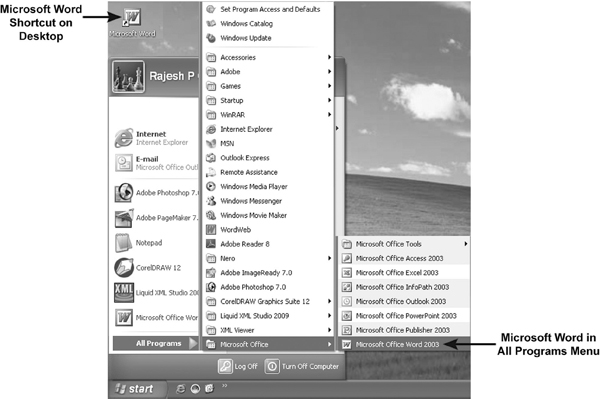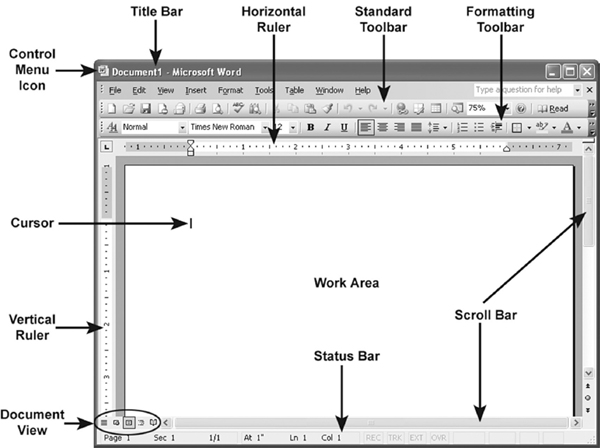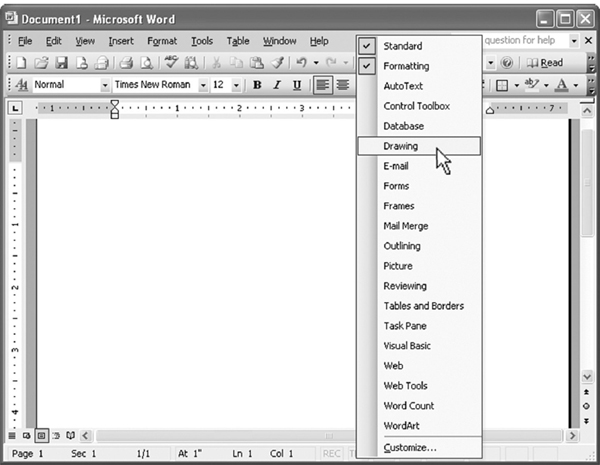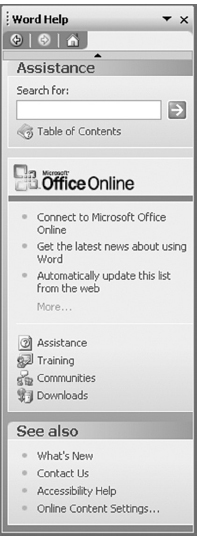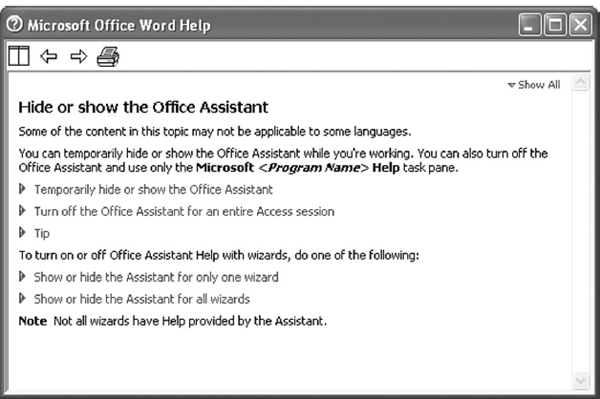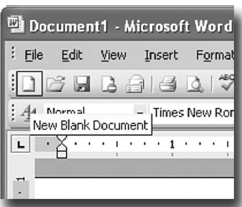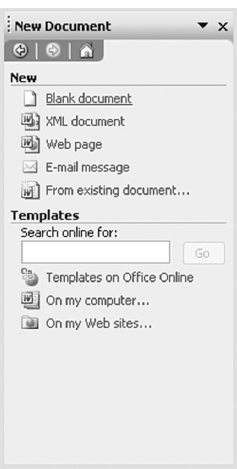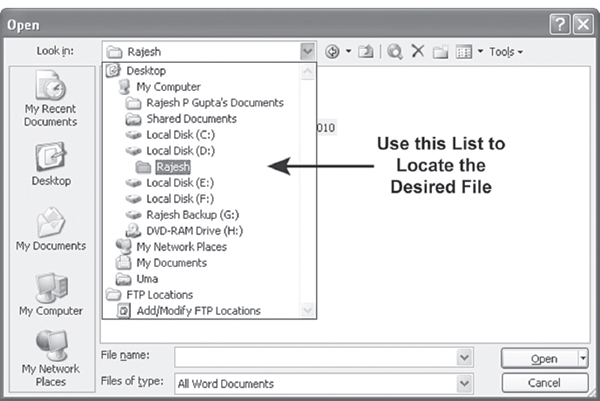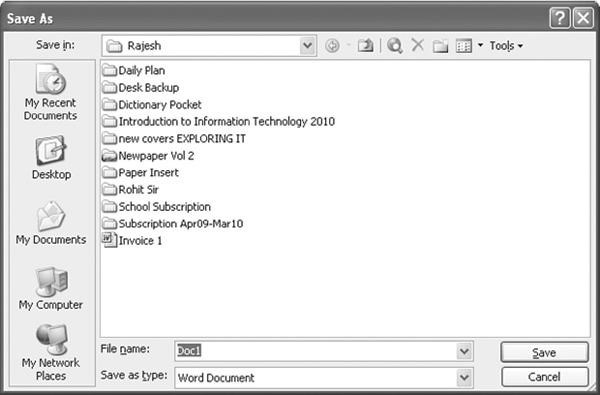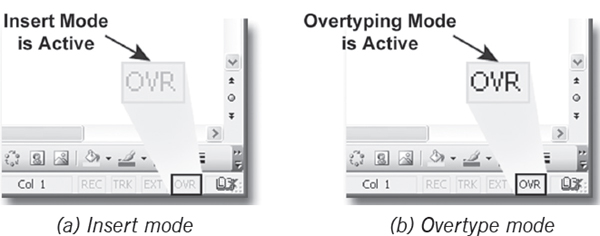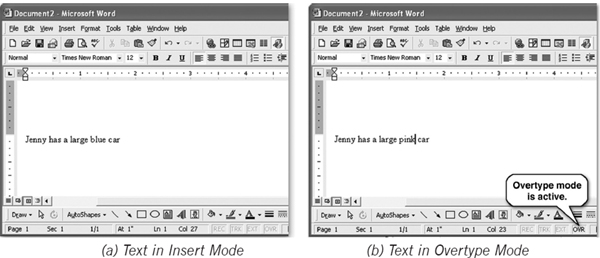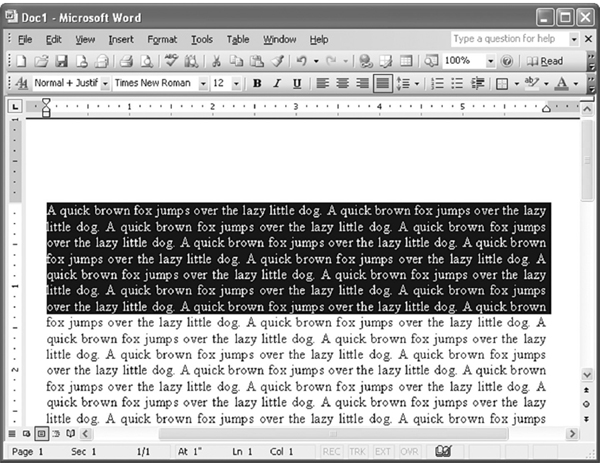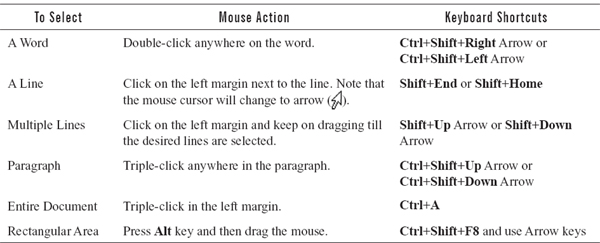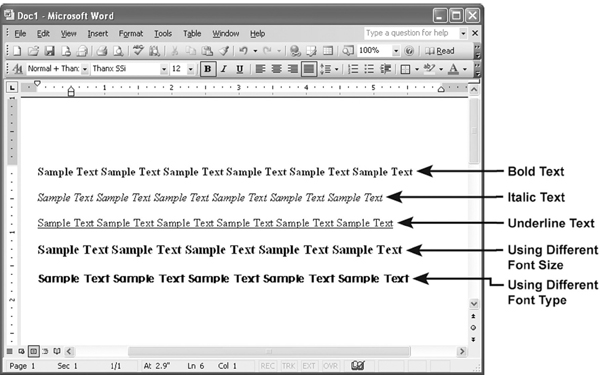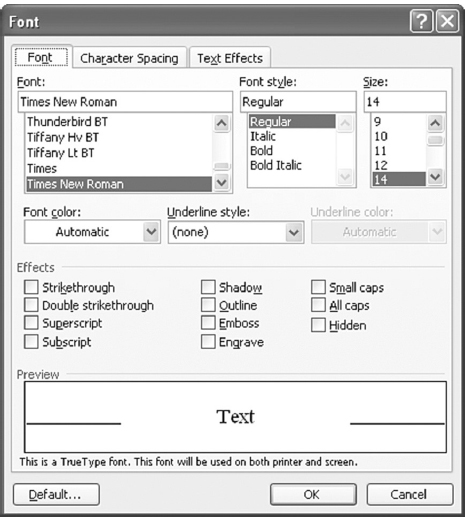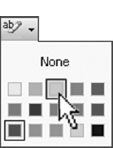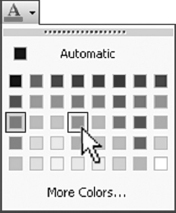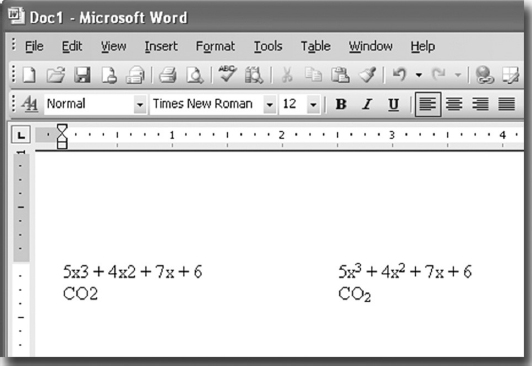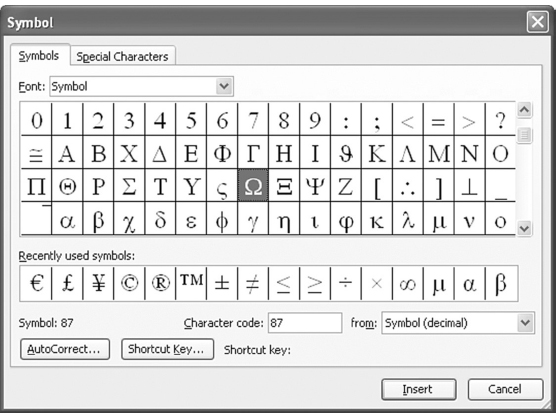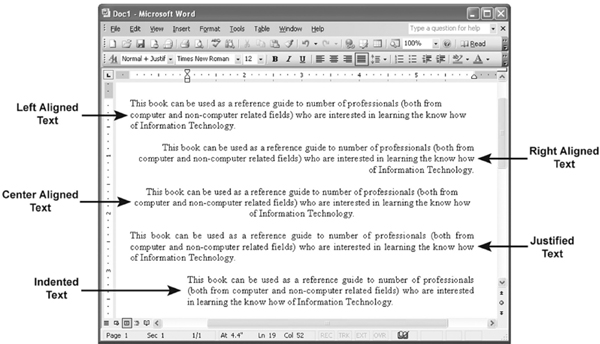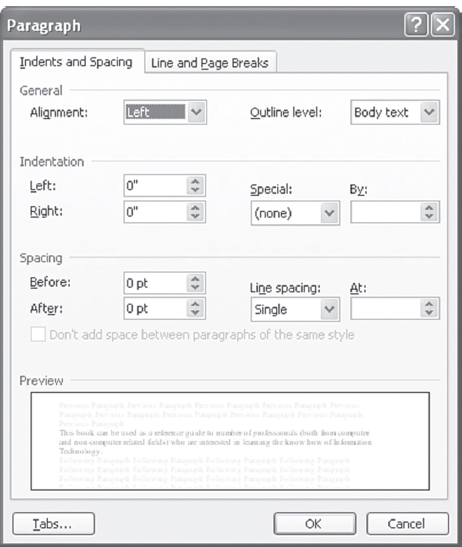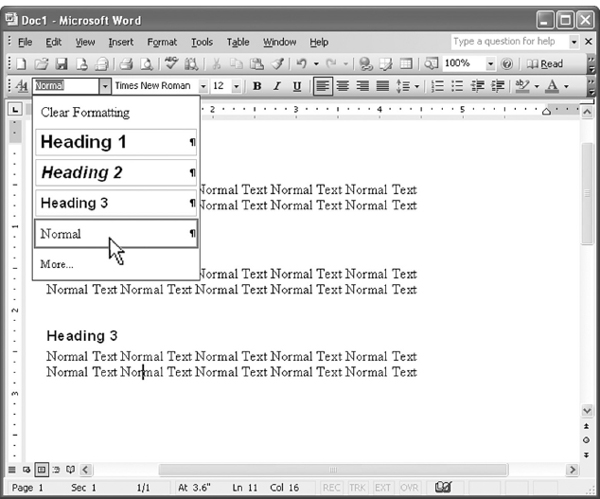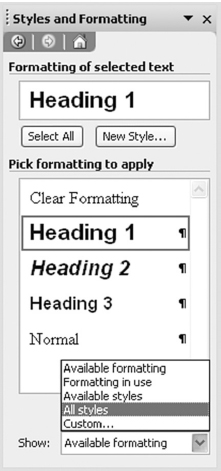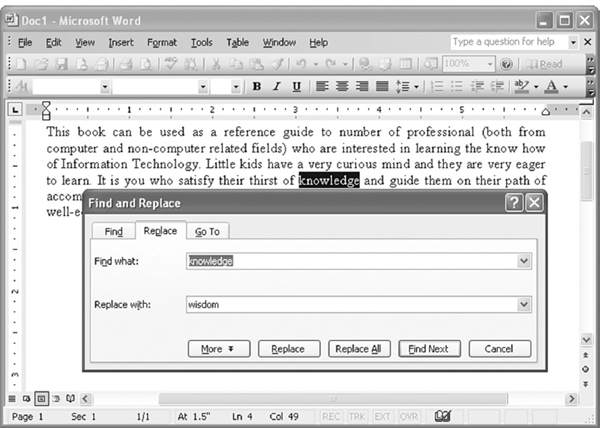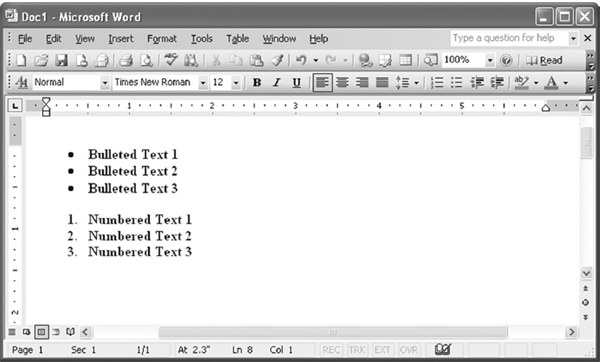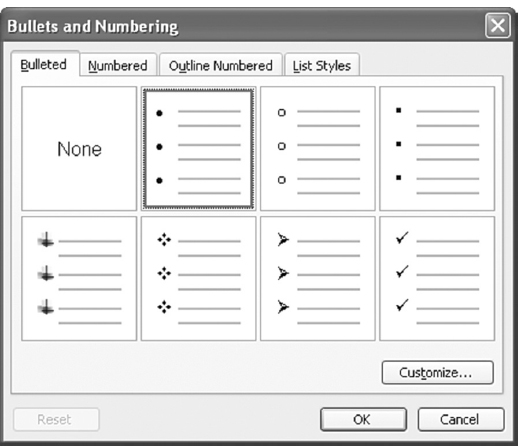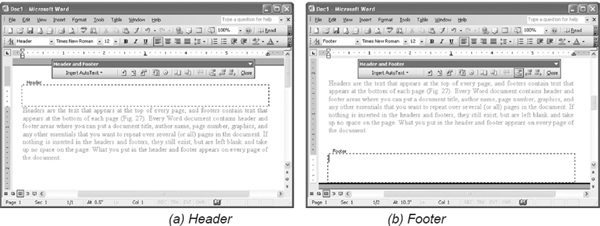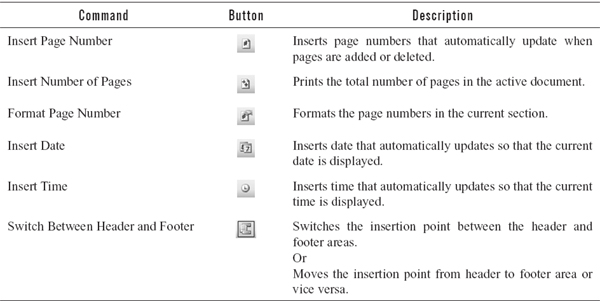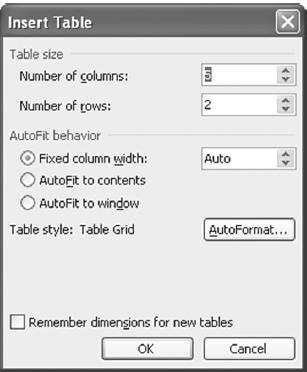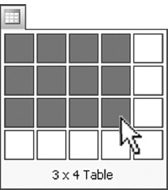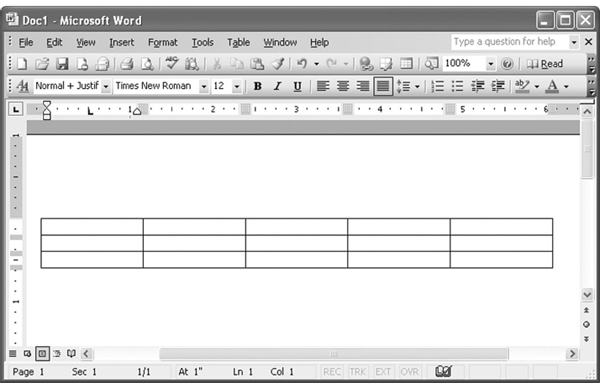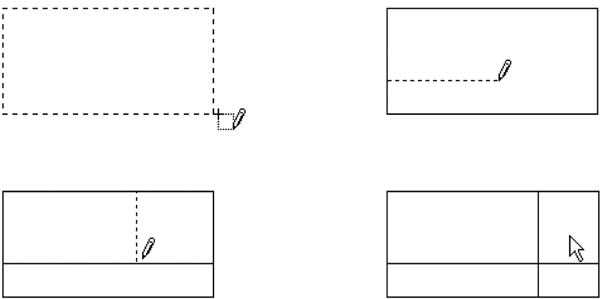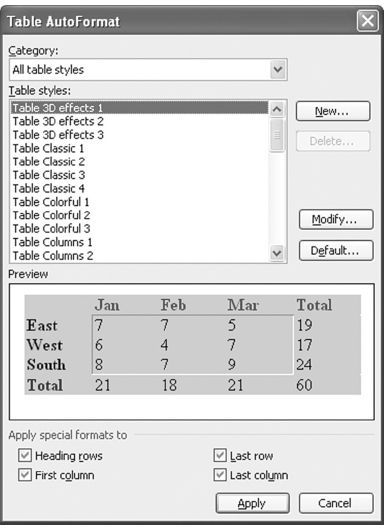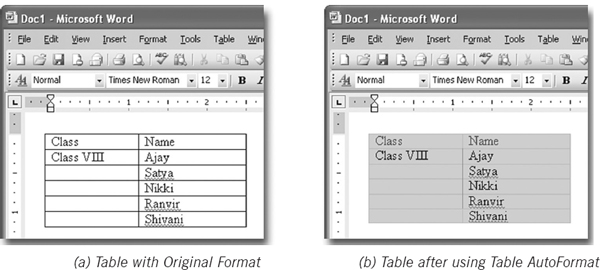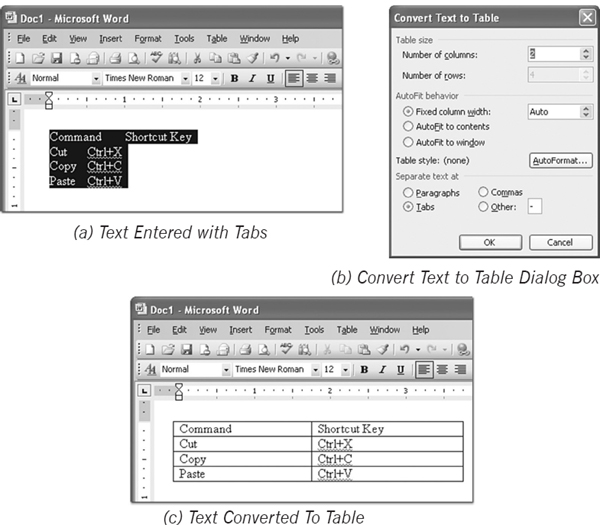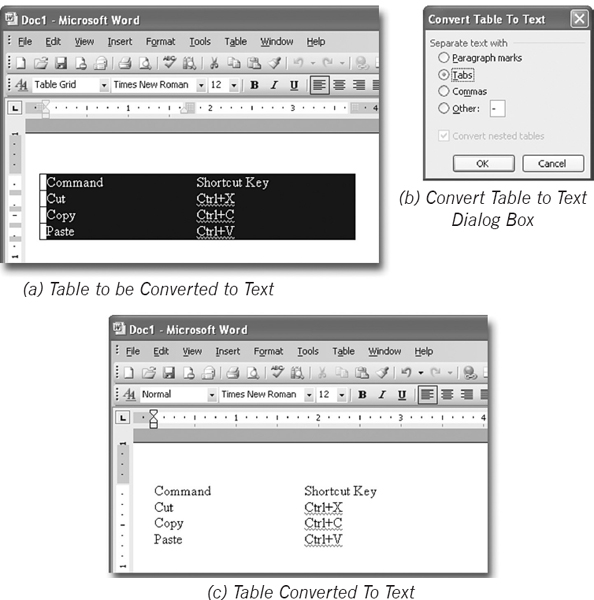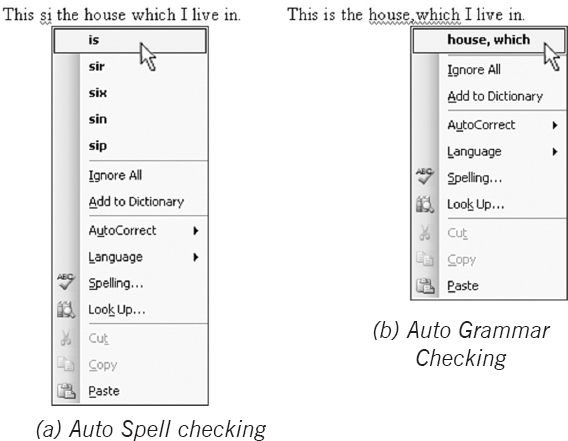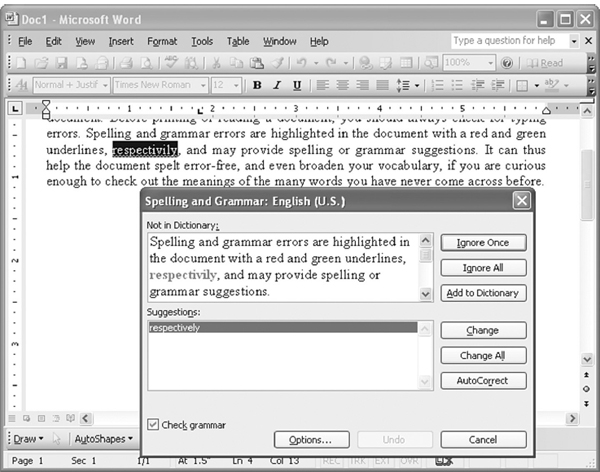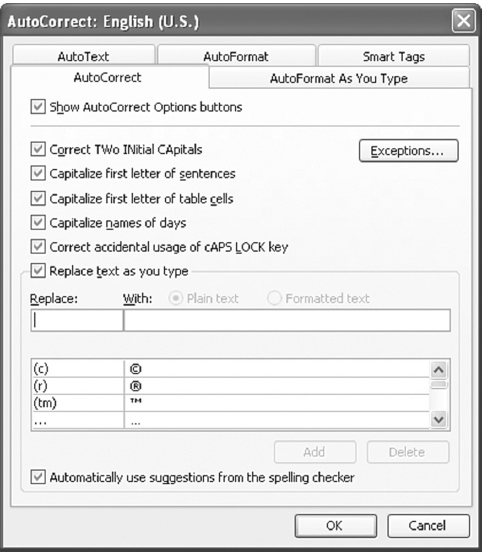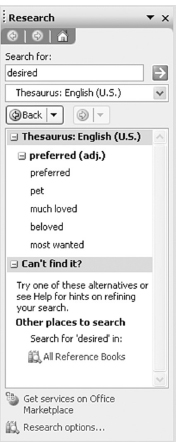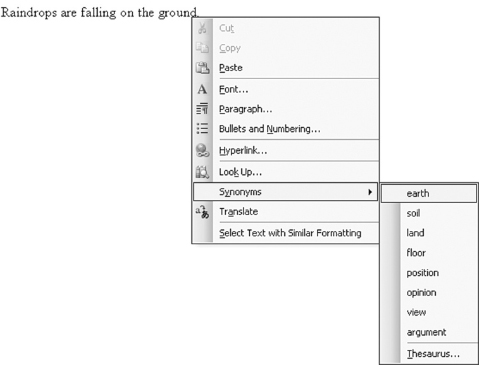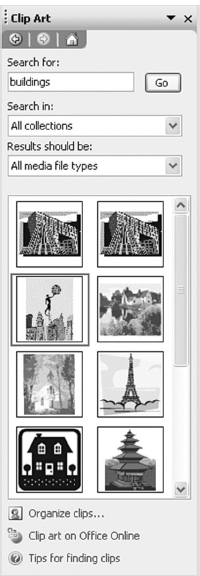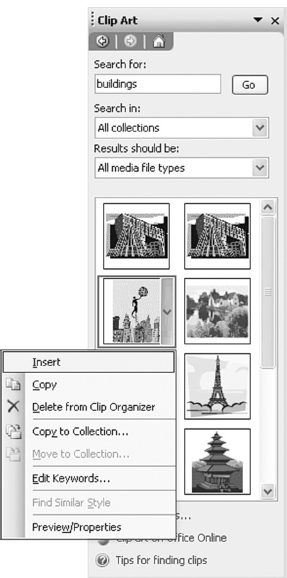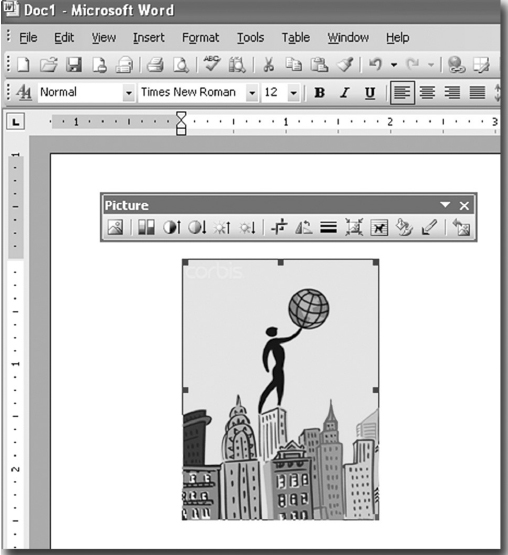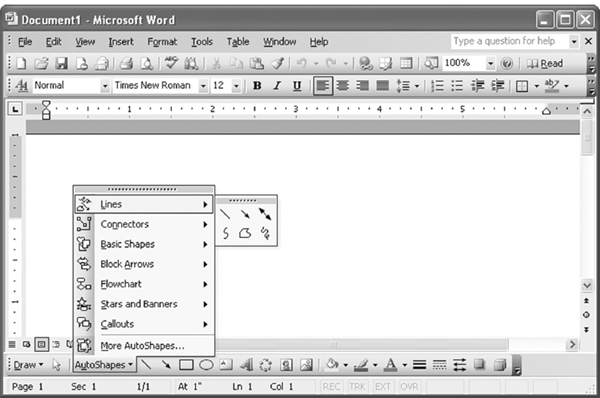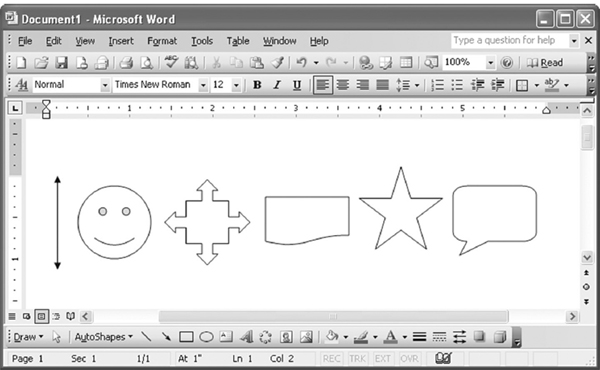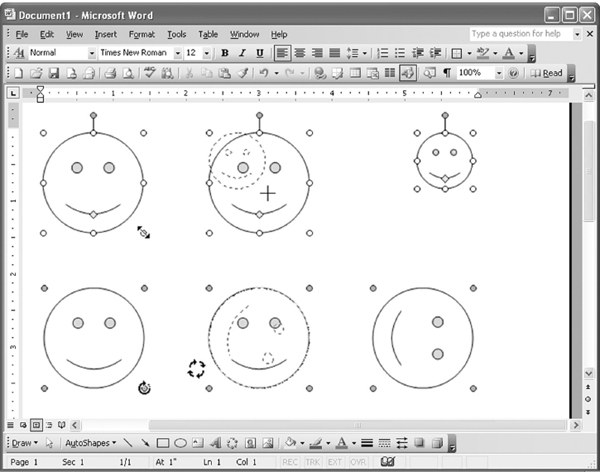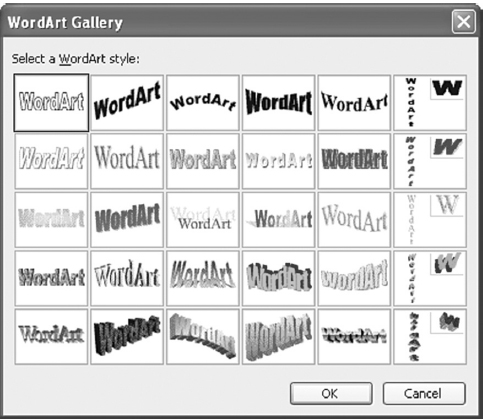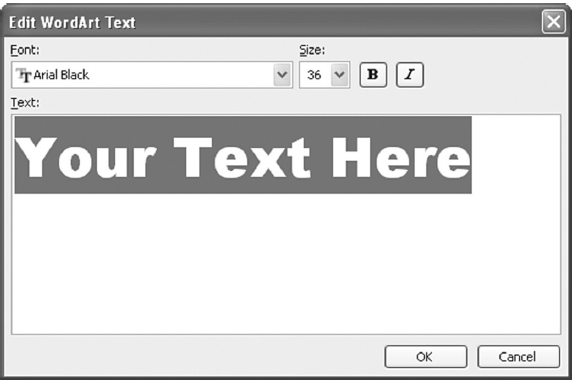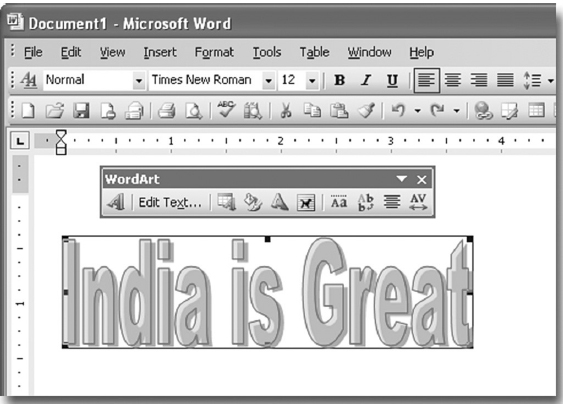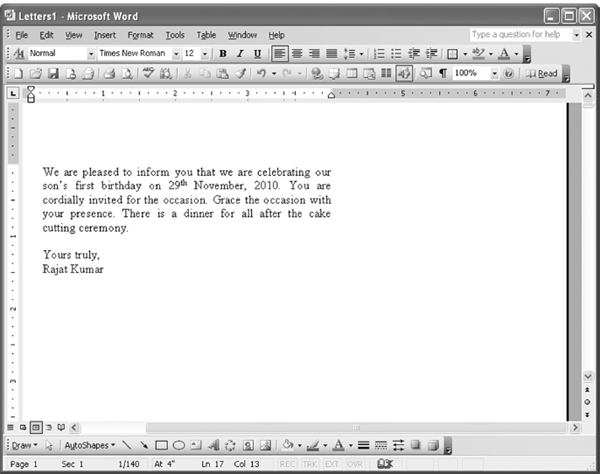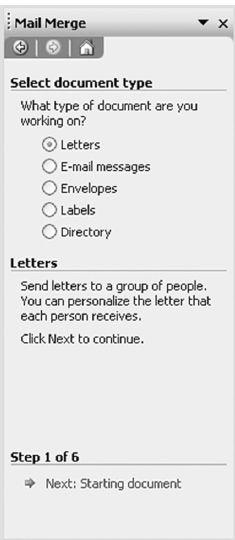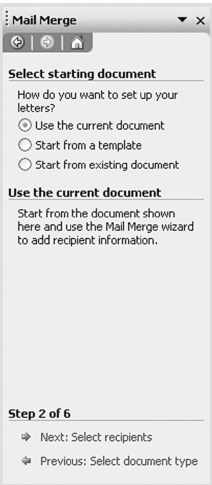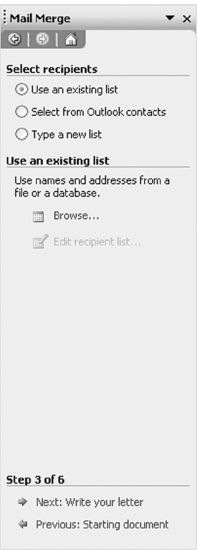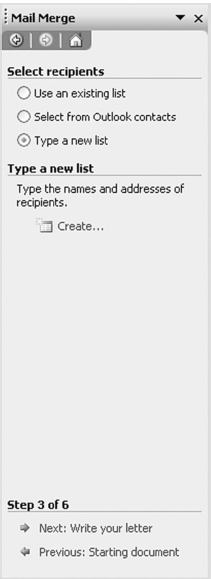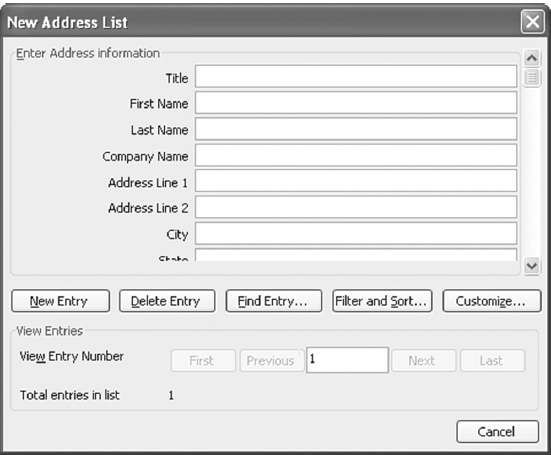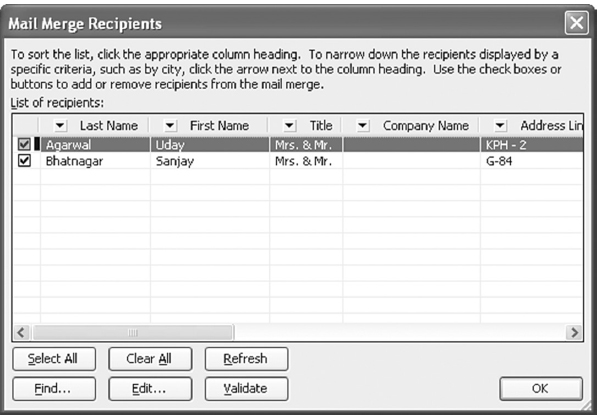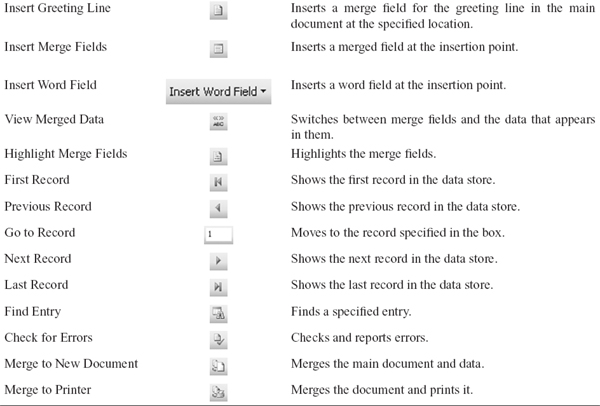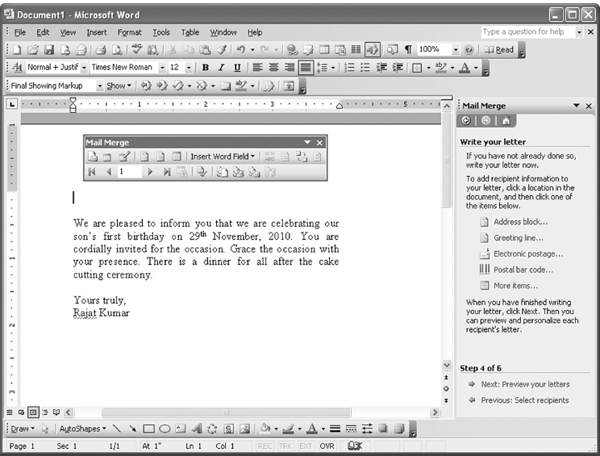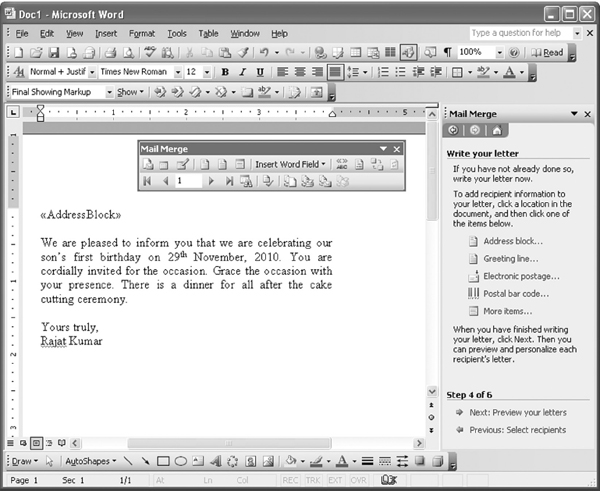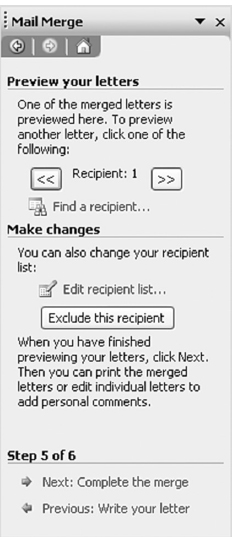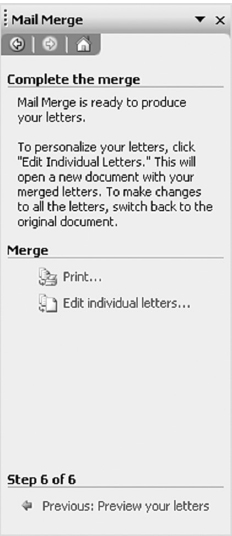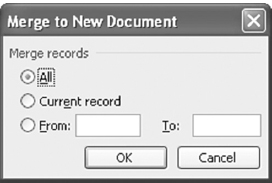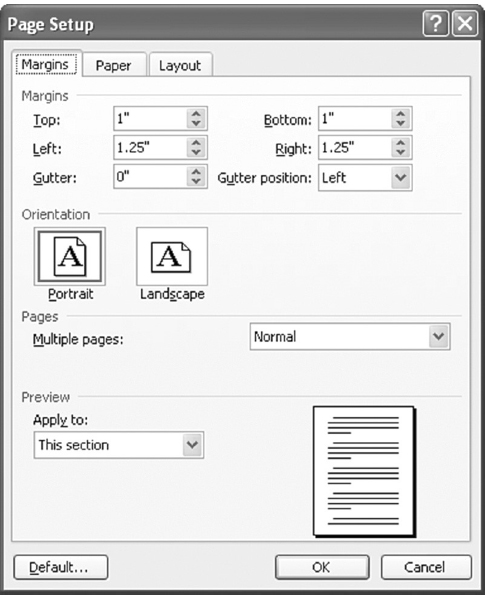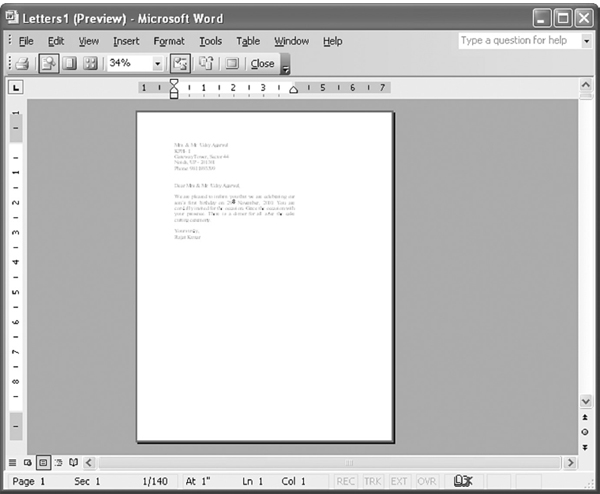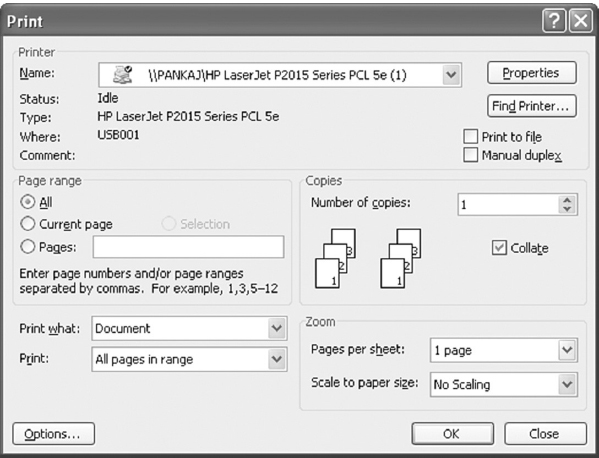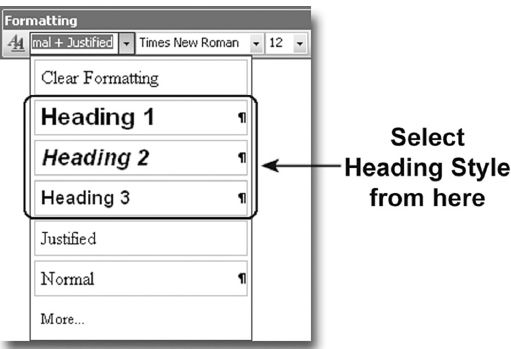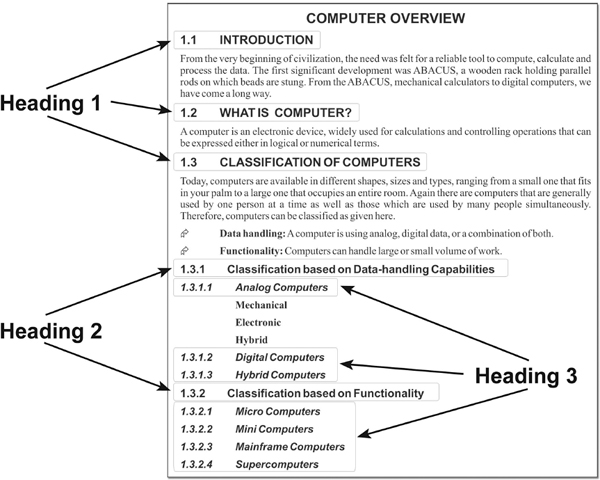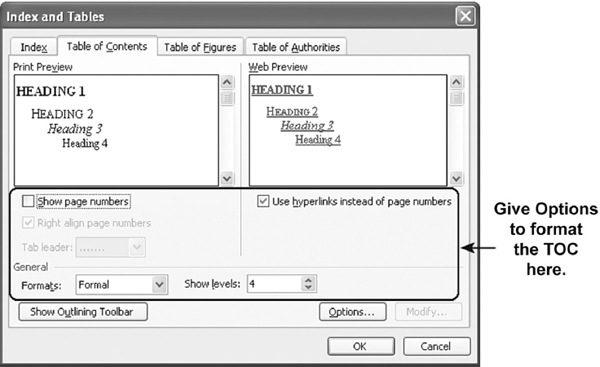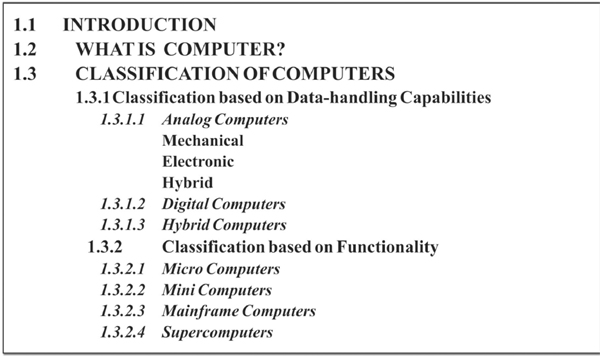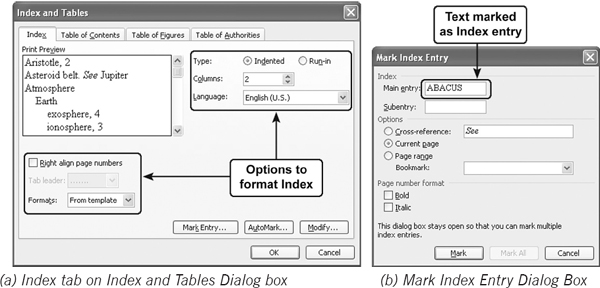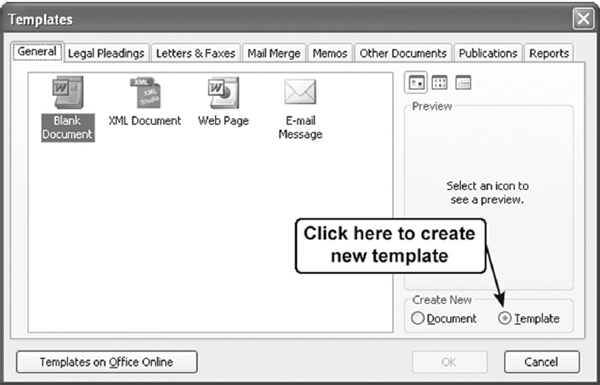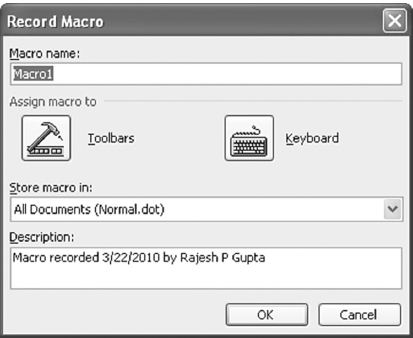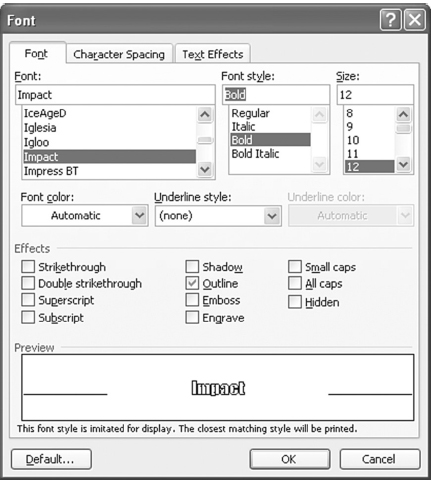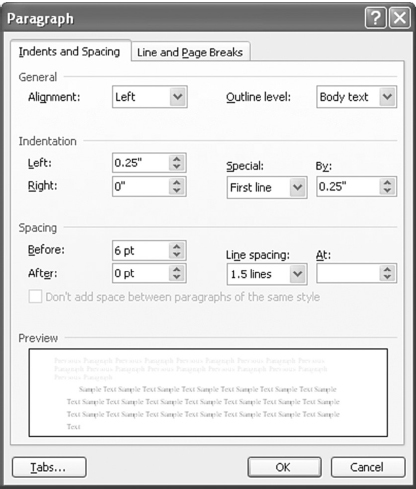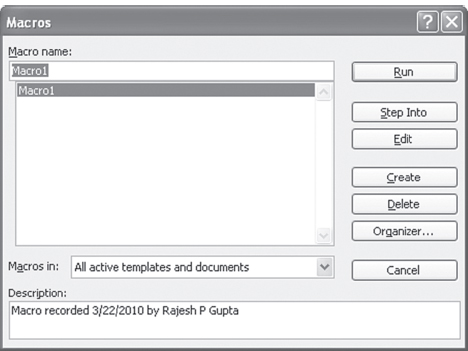7
MICROSOFT OFFICE WORD 2003
Chapter Outline
7.2 Starting Microsoft Office Word 2003
7.3 Working with Word 2003 Documents
7.6 Checking Spelling and Grammar
7.1 INTRODUCTION
Word processing is the manipulation of characters, words, text, numbers, sentences, and paragraphs in the document so that it is error-free and looks attractive. Initially, the work of preparing and formatting document was done manually with the help of typewriter, which was time consuming and could not be modified or used again. These days, this task is performed with the help of computers, making it much easier. A word processor is an application software for Word processing. It deals with character codes in the same objective way as a computer deals with number/codes. This results in reduced retyping time for error-free hard copy, facilitation of document revision, change before committing to paper, faster output speed, reduced proofreading and elimination of stationary wastage. Almost everyone has a need for this type of software because it can be used for common tasks.
With a word processing program, you can create letters, tables, newsletters, and academic papers that are easy to revise and much more aesthetically pleasing than documents created by a typewriter. The various Word processor packages that are being used are Word Perfect, Word Star, and Microsoft Word, etc. Out of all these word processing packages, Microsoft Word has a wide variety of features that make it one of the most popular and widely used applications. Microsoft Word produces professional documents quickly and efficiently.
Figure 7.1 Starting Microsoft Office Word 2003
7.2 STARTING MICROSOFT OFFICE WORD 2003
To open Microsoft Word, perform any one of the following steps.
- Double-click the Microsoft Word icon located on the desktop.
- Click start, point to All Programs, point to Microsoft Office and then select Microsoft Office Word 2003.
7.2.1 MICROSOFT WORD ENVIRONMENT
When Microsoft Word is opened, the main screen of the program appears. This main window has different components, which are described below in detail.
Title Bar
The title bar is located at the top of the Word window and displays the names of the application and active document. It also tells you which Microsoft Word application is currently active. At the extreme upper left corner of the title bar, there is a small Word icon (![]() ) (referred as the Control menu). Clicking this icon displays a pull-down menu, which contains options to change the size of the window and placement of the document. On the right end of the title bar, there are Minimize, Restore Down/Maximize, and Close buttons.
) (referred as the Control menu). Clicking this icon displays a pull-down menu, which contains options to change the size of the window and placement of the document. On the right end of the title bar, there are Minimize, Restore Down/Maximize, and Close buttons.
Figure 7.2 Main Microsoft Word Window
Menu Bar
The menu bar has many different menus, which control all options, functions, and commands for the entire Microsoft Word application. Each menu can be activated by pressing Alt+ the underlined letter of the menu from the keyboard. By default, Microsoft Word 2003 contains nine menus, which have an associated pull-down menu. For example, the File menu contains commands to open, create, and print a document.
Toolbars
Generally, a toolbar is positioned just below the menu bar. Toolbar contains command buttons that provide single-click entry to carry out many text-processing tasks. Word 2003 has 21 toolbars each having its own functions. By default, only Standard and Formatting toolbars are displayed in the Word environment. Additional toolbars like Drawing and Picture toolbars can be added by right-clicking on the menu bar and selecting the desired toolbar(s) from the pop-up menu, as shown in Figure 7.3. Alternatively, select Toolbars from the View menu, and then select the desired toolbar(s) from the pop-up menu.
Ruler
Microsoft Word has two rulers, Horizontal and Vertical. These rulers are used to change the format of a document by adjusting the indents, margins, tab stops, and table columns. You can hide or view rulers by clicking the Ruler option from the View menu.
Figure 7.3 Various Toolbars
Status Bar
The status bar is located at the bottom of the Word window and it provides information related to current cursor location, current page number, total number of pages, and program status notes (like Spelling and Grammar status, overtype mode indicators, etc.).
Work Area
The work area is the area in the middle of the Word window that allows you to type text, insert images, tables, and perform many more such actions. Within this area, small blinking vertical line (known as cursor) appears, which marks the position where the next typed character will appear in the work area.
Document View
Word can display the documents with varying levels of details through different views. The main difference between these views is your personal preference as to how you wish to work with the document. Microsoft Word provides the following views:
- Normal View: It displays text with character and paragraph formatting, but does not show headers and footers. This view separates pages with a dotted line, dividing the last line of one page from the first line of the next.
- Web Layout View: In this view, the document appears in a large font and with more space in between lines. The page layout is determined based on the computer screen rather than by the paper. This view is used to create documents for the Web.
- Print Layout View: This view displays a document in almost full WYSIWYG (what you see is what you get) preview mode. All character, paragraph, and document formatting options are displayed, along with headers and footers. The document is separated onscreen into what appear to be real pages.
- Outline View: This view displays a document as an outline with expandable and collapsible heading levels. It is used for rearranging entire sections of a document or for moving to specific section in a long document quickly.
- Reading Layout View: This view increases the readability of the content of the document. Pages represented in this view are designed to fit well on the screen. It hides all toolbars except for the Reading Layout and Reviewing toolbars.
- Document Map: In this view, a separate pane (known as Document Map) that shows a list of headings in the document is displayed. When you click a heading in the document map, the corresponding content is displayed in the work area. This view helps to navigate through the document quickly and keep track of your location in it.
- Thumbnails: In this view, small renderings of each page in your document are displayed in a separate pane. Using this view, you can get a visual impression of the content of each page. To jump directly to a page, you can click the corresponding thumbnail image.
Note: A pane is a part of the document window bounded by and separated from other parts by vertical or horizontal bars.
7.2.2 GETTING HELP
Microsoft Office provides an exhaustive help system to provide assistance when you are experiencing difficulty using any Office application. To get help, follow any one of the steps given below:
- Press the F1 key.
- Select Microsoft Office Word Help from the Help menu.
- Click the Microsoft Office Word Help button (
 ) on the Standard toolbar.
) on the Standard toolbar.
Figure 7.4 Word Help Task Pane
When you perform any of the above-mentioned actions, Word Help task pane appears.
In this task pane, simply type your question or keyword relevant to your topic in Search for box and click the (![]() ) button. Word will search through its help database and list topics related to the question you entered. If one of the topics listed appears to be what you are looking for, click on that topic to read its contents. Word will display the help topic alongside the Word window where you can read the topic or access any of the other help information (see Figure 7.5).
) button. Word will search through its help database and list topics related to the question you entered. If one of the topics listed appears to be what you are looking for, click on that topic to read its contents. Word will display the help topic alongside the Word window where you can read the topic or access any of the other help information (see Figure 7.5).
Once you have viewed the help information, click the Close button (located at the top right corner) to close the help window and return to the document.
Note: A task pane is a window within an office application that provides commonly used commands. You can use these commands while working on your document.
Figure 7.5 Getting Help
ScreenTips
A very handy feature provided by the Office applications is the ScreenTips. A ScreenTip is the message that appears on the screen to provide information about a toolbar button. The tip is displayed when the user rests the mouse pointer on the button, as shown in Figure 7.6. To hide the ScreenTip, simply move the mouse away from the button.
Figure 7.6 ScreenTip
7.3 WORKING WITH WORD 2003 DOCUMENTS
In this section, you will learn the steps required to perform the following in Word 2003.
- Creating a new document
- Opening an existing document
- Saving a document and making a backup copy
- Closing the document and Word application.
7.3.1 CREATING A NEW DOCUMENT
Whenever you start Word, it opens a new untitled document window so that you can begin a new project. If Word is already running, and you want to create a new document, click on New Blank Document button (![]() ) on the Standard toolbar. A new document can also be opened by following the steps given below:
) on the Standard toolbar. A new document can also be opened by following the steps given below:
- Select New from the File menu to display the New Document task pane (see Figure 7.7).
- Select Blank Document (
 ) under the New section. Word opens a new document, which is sequentially numbered like Document1, Document2, and so on. Similarly, you can also create an XML document, a web page, an E-mail message, and a document from the existing document by selecting appropriate options.
) under the New section. Word opens a new document, which is sequentially numbered like Document1, Document2, and so on. Similarly, you can also create an XML document, a web page, an E-mail message, and a document from the existing document by selecting appropriate options.
Figure 7.7 New Document Task Pane
7.3.2 OPENING AN EXISTING DOCUMENT
To open an existing document, follow any of the steps given below:
- Select Open from the File menu to display the Open dialog box (see Figure 7.8). You can also open the Open dialog box by clicking on the Open button (
 ) on the Standard toolbar. The Open dialog box allows you to specify the name of the desired file in the File name drop-down box. If the desired file is not in the current location, you can locate it by navigating through Look in drop-down box. Once the file is found, select the file and click the Open button.
) on the Standard toolbar. The Open dialog box allows you to specify the name of the desired file in the File name drop-down box. If the desired file is not in the current location, you can locate it by navigating through Look in drop-down box. Once the file is found, select the file and click the Open button. - Word document can also be opened by double-clicking the Word file icon, placed on the specified location.
Figure 7.8 Open Dialog Box
7.3.3 SAVING A DOCUMENT
Once a document is created, you can start typing the text, and insert graphics and tables. When this is done, you must save the document for future references. To save the document, Microsoft Word provides two menu options, namely, Save and Save As. Although both these commands have similar functions, they differ in one aspect. When you create a new document and click the Save button (![]() ) on the Standard toolbar or choose Save from File menu, the Save As dialog box is displayed. This dialog box allows you to specify the name of the file, where to save the file, and the file type of the document (whether to save it as a web page or in rich text format).
) on the Standard toolbar or choose Save from File menu, the Save As dialog box is displayed. This dialog box allows you to specify the name of the file, where to save the file, and the file type of the document (whether to save it as a web page or in rich text format).
THINGS TO REMEMBER
Saving a File
Once you have saved the new document, clicking on the Save button does not display any dialog box because Word assumes that you do not want to specify the name or the location of the document again. Word assumes that you just want to update the originally saved copy by overwriting it with this new version of the same file. If you do want to put a copy of this same file in a new location, create a new copy with a new name, or change the file type, you must go to the File menu and choose Save As. This way, you can save your file at different stages and keep multiple versions on your hard drive.
Figure 7.9 Save As Dialog Box
In the Save As dialog box, you can use the drop-down box at the top, labelled Save in, to select the location where the new copy is to be saved. You can also change the name of the copy by typing new name in File name box and then save it either in a new location or in the same location as the original (because this new copy now has a different name). Furthermore, you can change the file type by selecting a file type from the Save as type drop-down box at the bottom of the Save As dialog box.
Note: By default, Microsoft Word documents are saved with .DOC extension. Although it can also be saved in other file formats like .TXT, .RTF, and .HTML.
7.3.4 CLOSING A DOCUMENT AND EXITING MICROSOFT WORD
After finishing all the Word processing activities, you may want to close the document and exit Word. For this, follow any of the steps given below:
- Select Close from File menu to close the document and select Exit from File menu to close the Word program.
- Click on the Close Window button at the upper right corner of the Word window to close the current document. Note that when a single document is opened in Word then there are two close buttons. One is located at the top of the application window, which closes the Word application while the second (lower) one present on the document closes only the current file. If a user makes changes to a file and has not saved those changes, Word will ask whether to save the changes before closing the file.
Figure 7.10 Closing a Document and Exiting Microsoft Word
7.4 WORKING WITH TEXT
In the previous section, we discussed how to create and save a Word document. Now let us learn how to enter, select and format text. Apart from these activities, you will also learn how to align and indent the text, copying and moving text, finding and replacing words, undo and redo operations, making lists, and inserting headers and footers.
7.4.1 INSERTING TEXT
Before Word can perform operations on text such as moving and copying, it is necessary that some text is present or typed in a document. To enter the text, just create or open a document and start typing. Note that the text appears where the blinking cursor (|) is located. If you want to type in capitals (like ITLESL instead of itlesl), activate the Caps Lock key by pressing it once. You can also use the Shift key to type the text in capitals.
In Word, there are two typing modes, namely, insert mode and overtyping mode. In the insert mode, the newly typed text does not replace the already written text, instead the existing text is pushed forward. On the other hand, in overtyping mode, the newly typed text replaces the already written text. To check whether you are in the insert mode or not, look at the status bar located at the bottom of the screen. If the letters OVR are grey, you are in the insert mode and if they are in black, you are in the overtype mode.
FACT FILE
The tab is designed to make it easier to align text easily and precisely. Each time the TAB key is pressed, the cursor moves 0.5” along the line of text by default. When the TAB key is pressed, the text to the right of the cursor is moved to the right.
By default, the insert mode is automatically activated. To change to the overtyping mode, double-click the letters OVR on the status bar. You can toggle between insert and overtype mode by double-clicking it again and again. Let us consider an example of inserting text in the overtyping mode.
Figure 7.11 Typing Modes
Suppose, you want to edit the content in a document from “Jenny has a large blue car” to “Jenny has a large pink car”, follow the steps given below:
- Type the text ‘Jenny has a large blue car’.
- Place the cursor before the letter ‘b’ in ‘blue’.
- Enable the overtype mode.
- Type the word pink.
- The sentence should now read—‘Jenny has a large pink car’.
Figure 7.12 Using Overtyping Mode
7.4.2 SELECTING TEXT
Before performing any operation on text such as moving, copying, formatting etc., the text must be selected. Whenever you select text, it gets highlighted.
Depending on your requirement, you can select a word, a line, or multiple lines, etc. You can select a word, a line, or multiple lines, etc using mouse as well as keyboard shortcuts as listed in Table 7.1.
Figure 7.13 Selected Text
7.4.3 FORMATTING THE TEXT
As you enter and edit text, you can change its appearance to add emphasis and make the document easier to read. This is known as formatting. It is the process of determining how the typed text will appear on a printed page. Formatting is applied by altering the appearance of text by setting the typeface (font), size, line spacing, and colour. Formatting can be done by using the Formatting toolbar or by using the Format menu. To format text, follow the steps given below:
- Select the text to be formatted.
- Use buttons on the Formatting toolbar to format the selected text. Some of the buttons used in formatting text are given in Table 7.2.
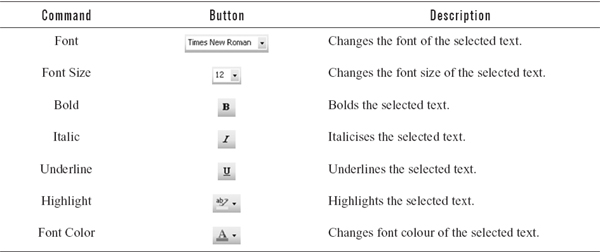
Text can also be formatted using the Font dialog box. For this, follow the steps given below:
- Select the text to be formatted.
- Select Font from the Format menu to display the Font dialog box (see Figure 7.15).
Figure 7.14 Formatting Text
- From this dialog box, the font, font style, and text size can be specified. This dialog box also allows you to apply underline, colour, and other effects to the selected text.
- Note that formatting is displayed in the Preview box at the bottom of the Font dialog box. Once formatting is done, click OK to apply the formatting changes to the selected text.
Figure 7.15 Font Dialog Box
Highlighting and Changing Text Colours
While working in Microsoft Office applications like Word, Excel, and PowerPoint, you may wish to change the attributes of some important phrases or words. This can be done by changing the font size, making them appear bold, italic, or underlined. Apart from these formatting techniques, Microsoft Office also allows you to emphasise important words or sentences by changing their font and/or background colour.
To highlight the text, just as you would do with a highlighter pen in case of textbooks, Microsoft Office provides you with a Highlight tool. To highlight existing text, follow the steps given below:
Figure 7.16 Highlight Colours
- Click on the down arrow beside the Highlight button (
 ) on the Formatting toolbar (see Figure 7.16).
) on the Formatting toolbar (see Figure 7.16). - Select the desired colour from the drop-down list to highlight text.
- When you move on to the document, the mouse pointer changes to (
 ). Now, click and drag the mouse to select the text to be highlighted.
). Now, click and drag the mouse to select the text to be highlighted. - After finishing with text highlighting, click on the Highlight button again to turn it off, or simply press the Esc key.
By default, Microsoft Word displays and prints the text in black. In case you want to change the colour of the text, follow the steps given below:
- Select the text for which you want to change the colour.
- Click on the down arrow beside the Font Color button (
 ) from the Formatting toolbar (see Figure 7.17).
) from the Formatting toolbar (see Figure 7.17). - Select the desired colour from the pull-down list for the selected text.
Figure 7.17 Font Colours
Figure 7.18 Changing Text to Subscript and Superscript
Text Manipulation with Scientific Notation
You might have observed various mathematical expressions like 5x3 + 4x2 + 7x + 6 and chemical formulas like CO2. In the expression 5x3 + 4x2 + 7x + 6, the digits 3 and 2 appear slightly above the normal baseline, and in the formula CO2, the digit 2 appears slightly below the baseline. A character appearing above the baseline is known as a superscript and a character appearing below the baseline is known as a subscript. Subscript and superscript formats can be easily applied to the text in the Word.
To apply a subscript or a superscript format to a character (or text) in a document, follow these steps.
- Select the character (or text) on which subscript or superscript format is to be applied.
- Select Font from the Format menu to display the Font dialog box (see Figure 7.18).
- In the Effects section, select the Superscript checkbox or the Subscript checkbox according to the requirement.
- Click OK to close the Font dialog box and apply the formatting changes to the selected text.
Inserting Symbols
Special characters that generally cannot be typed from the keyboard are known as symbols. These are the characters like summation symbol (Σ), alpha (α), pi (π), etc. that are mostly used in mathematical and scientific formulas. Word also allows you to insert many more symbols other than mathematical and scientific symbols in a document.
To insert a symbol in a document, follow these steps.
- Select Symbol from the Insert menu to display the Symbol dialog box in which Symbols is the active tab.
- Select the desired symbol from the Font drop-down box (see Figure 7.19) and click Insert. The selected symbol is inserted in your document. After insertion, the Cancel button changes to Close button.
- Click Close to close the Symbol dialog box.
Figure 7.19 Inserting a Symbol
7.4.4 ALIGNING AND INDENTING TEXT
Alignment and indentation operations are a part of paragraph formatting. These operations are performed to give a well-defined “structure” to the document. This gives the document a professional look. To align or indent a paragraph, follow the steps given below:
- Select the paragraph to be aligned or indented.
- Use buttons on the Formatting toolbar to align or indent the paragraph. Some of the buttons used in aligning or indenting paragraph are given in Table 7.3.
Table 7.3 Paragraph Formatting
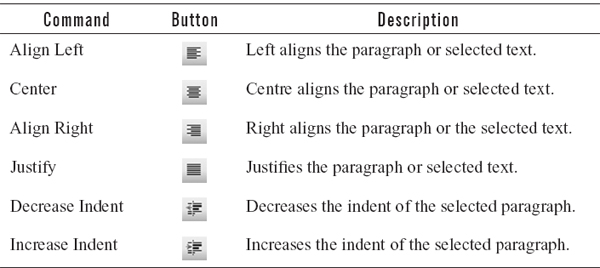
A paragraph can also be formatted using the Paragraph dialog box. For this, follow these steps.
Figure 7.20 Paragraph Formatting
- Select the paragraph to be formatted.
- Select Paragraph from the Format menu to display the Paragraph dialog box.
- Specify the desired alignment and indentation for selected paragraph.
- Note that formatting is displayed in the Preview box at the bottom of the Paragraph dialog box. Once formatting is completed, click OK to apply the formatting changes to the selected paragraph.
Figure 7.21 Paragraph Dialog Box
7.4.5 FORMATTING STYLE
Formatting the text using various menu options and toolbar buttons is viable for small documents with only a few pages. However, when a document contains many pages, or when consistent formatting is crucial, you should use Styles instead.
Styles can significantly reduce the time it takes to format a document. For example, if a document is divided into sections with headings (like this book has), it is a good idea to use heading styles. It is much easier to maintain consistency in a document if styles are used. For example, if a heading style is used in a document and you want to change the appearance of the heading, just alter the definition of the style. This change will be cascaded through all headings in the documents that were created using the style, so you do not have to select each one and make the formatting changes individually.
To apply a style, follow the steps given below:
- Place the cursor in the paragraph where the style is to be applied.
- Click the Style drop-down box on the Formatting toolbar and select a style by clicking on it (see Figure 7.22).
FACT FILE
Style
A style is a set of formatting specifications that can automatically be applied to the text. In smaller documents, you can alter the appearance of text by changing the font size and colour, adjusting paragraph settings, aligning and indenting text. These settings can be applied one at a time by clicking toolbar buttons, using the keyboard or dialog boxes. Instead of applying these settings one at a time, a combination of different character and paragraph formats can be incorporated into a style.
Figure 7.22 Style Box
Accessing all Available Styles
For simplicity, Microsoft Word 2003 only displays a small number of the built-in styles in the Style box of a new document. If you want any of the other styles to be available, you have to open the Style dialog box. This can be done by following the steps given below:
- Select Styles and Formatting from the Format menu to display the Styles and Formatting task pane.
- Select All styles from Show drop-down box to display all the styles.
- Click on the style you want to apply on the text.
7.4.6 FORMAT PAINTER
A handy feature for formatting text is the Format Painter. For example, if you are formatting a paragraph heading with a certain font face, size, and style, and you want to format another heading the same way, you need not manually add each attribute to the new headline. Instead, you can use the Format Painter, which is a time saving feature for quickly copying the format of a block of text. This can be done by following the steps given below:
- Select the text containing the formatting you wish to copy.
- To copy formatting to a single location, click once on Format Painter button (
 ) on the Standard toolbar. To copy it to multiple locations, double-click on Format Painter button. Notice that the mouse pointer changes to resemble a paintbrush (
) on the Standard toolbar. To copy it to multiple locations, double-click on Format Painter button. Notice that the mouse pointer changes to resemble a paintbrush ( ).
).
Figure 7.23 Styles and Formatting Task Pane
- Now click and drag the mouse to select the text you wish to format, and then release the mouse.
- If the format painter is copied by double-clicking, press the Esc key to come out of painter mode.
7.4.7 USING CUT, COPY, AND PASTE IN WORD
When you are working on a document, sometimes you may decide to move a certain portion of text (or even images), or copy the same text or image into some other area or in some other document. If text is to be moved within the same document or to another document, it should be first cut and then pasted. When you choose to cut the text, Word removes it from the current document and places it in the clipboard, a temporary storage area in computer memory. Now to place the text stored in the clipboard, you will have to perform the paste action. Copying the text is similar to the cut operation, except that copy retains the text at the original place, but in case of cut, the text is removed from the original location. To perform the cut, copy and paste, follow the steps given below:
- Select the text that is to be moved or copied.
- In case you want to move the text, choose Cut from the Edit menu or click the Cut button (
 ) on the Standard toolbar. If you want to copy the text, choose Copy from the Edit menu or click the Copy button (
) on the Standard toolbar. If you want to copy the text, choose Copy from the Edit menu or click the Copy button ( ) on the Standard toolbar.
) on the Standard toolbar. - Click the mouse on the place in the document where you want to insert the text.
- Choose Paste from the Edit menu or click the Paste button (
 ) on the Standard toolbar. The text that you copied to the clipboard is pasted to the place where the mouse is clicked.
) on the Standard toolbar. The text that you copied to the clipboard is pasted to the place where the mouse is clicked.
7.4.8 FINDING AND REPLACING TEXT
Find and replace option in Microsoft Word is used to locate a particular word, phrase, or set of characters in a document, and replace it with something else. Although you could manually scan through the document for find and replace purposes, it takes time and there is always the possibility that you might miss the text in question on a first or second pass. Microsoft Word's Find and Replace feature swiftly and unerringly locates anything you are looking for, and once the desired text is located, it can automatically be replaced by the new text. For example, if you have used word, say “January 2004” in the document and later want it to be replaced with “January 2005”, Word finds all instances of “January 2004” and replaces it with “January 2005”. Microsoft Word also finds and replaces all grammatically wrong word(s). For example, if you want to replace the word “narrow” with the word “broad” throughout a document, Word intelligently changes not only “narrow” to “broad”, but also words like “narrower” to “broader”.
To find and replace text within the document, follow the steps given below:
- Select Find from the Edit menu to display the Find and Replace dialog box.
- Click on the Find tab if you want to find the desired word in the document, or click Replace tab to find a word and replace it with new word.
- Type the text that you want to search in the Find what box.
- Click Find Next button to find the first occurrence of the text. If you want to replace the text then select the Replace tab and type the replacement text in the Replace with box.
- Select Replace button to replace each occurrence of the word individually or click Replace All to replace all occurrences of the word at once. Word will display a message when it has replaced all occurrences.
- Keep on pressing the Find Next and Replace button until you are finished with finding and replacing the text.
- To close the Find and Replace dialog box, click the Cancel button or press the Esc key.
Figure 7.24 Find and Replace Dialog Box
7.4.9 UNDO AND REDO
Microsoft Office is a very powerful suite of applications. These applications remember all the actions that you performed on a file. If a portion of a document is deleted or changed, you can revert to the original state by using the Undo command. This feature instructs the application to ignore the last action (whether it was deleting, copying, or moving). Word 2003 has virtually unlimited capacity of performing undo action, as long as you do not close the document. However, certain actions like saving a file or printing a page cannot be undone.
To undo the last action(s), click the Undo button (![]() ) on the Standard toolbar, or select Undo from the Edit menu. If you want to undo a number of actions at the same time then click the down arrow (
) on the Standard toolbar, or select Undo from the Edit menu. If you want to undo a number of actions at the same time then click the down arrow (![]() ) beside the Undo button to display a list of actions that can be undone (see Figure 7.25 (a)).
) beside the Undo button to display a list of actions that can be undone (see Figure 7.25 (a)).
Figure 7.25 Undo and Redo Actions
If an undo action is set and then you want to reverse it then Redo command can be used to reverse the undo action. To redo the last undo action, click on the Redo button (![]() ) on the Standard toolbar, or select Redo from the Edit menu. If you want to redo a number of actions at the same time then click the down arrow (
) on the Standard toolbar, or select Redo from the Edit menu. If you want to redo a number of actions at the same time then click the down arrow (![]() ) beside the Redo button to display a list of actions that can be redone (see Figure 7.25 (b)).
) beside the Redo button to display a list of actions that can be redone (see Figure 7.25 (b)).
7.4.10 BULLETS AND NUMBERING
In many situations, you need to prepare a list of actions. For example, while writing an algorithm it is always advisable to use bullets and numbering to list all the steps. If these steps are written in a paragraph form, separated only by colons or commas, it may become difficult to understand the text. Microsoft Word 2003 supports list-makers with its bullets and numbering features. To use bullets and numbering, first select the text you want to format. Next, use the Bullets (![]() ) or Numbering (
) or Numbering (![]() ) button on the Formatting toolbar to apply bullets or numbering.
) button on the Formatting toolbar to apply bullets or numbering.
Figure 7.26 Bulleted and Numbered Text
Figure 7.27 Bullets and Numbering Dialog Box
Bullets and numbering can also be applied to text by selecting Bullets and Numbering from the Format menu. This will display the Bullets and Numbering dialog box (see Figure 7.27). To apply bullets, use the Bulleted tab, and if a numbered list is to be made, use the Numbered tab. There are seven default bullet formats (and seven default numbering formats) available in the dialog box. You can modify any of these to create your own formats.
If you want to remove the bullets or numbering, select the text and click the Bullets or Numbering button on the Formatting toolbar.
7.4.11 HEADER AND FOOTER
Headers are text that appears at the top of every page, and footers contain text that appears at the bottom of each page. Every Word document contains header and footer areas where you can put a document title, author name, page number, graphics, and any other essentials that you want to repeat over several (or all) pages in the document. If nothing is inserted in the headers and footers, they still exist, but are left blank and take up no space on the page. What you put in the header or footer appears on every page of the document.
To create a header and footer in a document, follow the steps given below:
- Select Header and Footer from the View menu. This displays the Header and Footer toolbar with a dotted box for header at the top of the page and a dotted box for footer at the bottom of the page (see Figure 7.28).
Figure 7.28 Header and Footer
- Type the text in Header and/or Footer box. Note that headers and footers can be formatted (like changing font colour, size, etc.) just like any other text.
- If necessary, use appropriate options from the Header and Footer toolbar to add time, insert page number, date, etc., as listed in Table 7.4.
- After text or graphic has been entered, click Close button on the Header and Footer toolbar or double-click in the work area to return to work there.
7.5 WORKING WITH TABLES
Tables are one of the most powerful features of Microsoft Word. They provide a means of presenting information in an organised and attractive manner that displays text in a grid of rows and columns of cells.
In Microsoft Word 2003, tables can be created in number of ways.
- Select Insert from the Table menu and then choose Table from the pop-up menu to display the Insert Table dialog box (see Figure 7.29), from where you can choose the number of columns and rows required in the document. Note that you can always add or delete columns and rows at a later stage.
- Another way of creating a table is to click the Insert Table button (
 ) on the Standard toolbar. Drag the mouse along the grid, highlighting the number of rows and columns for the table (see Figure 7.30).
) on the Standard toolbar. Drag the mouse along the grid, highlighting the number of rows and columns for the table (see Figure 7.30).
Figure 7.29 Insert Table Dialog Box
Figure 7.30 Inserting Table by Dragging
When you select any of the above two methods, the table will be inserted into the document as shown in the Figure 7.31.
- A table can also be drawn onto the document. To draw a table, select Draw Table from the Table menu or click the Tables and Borders button (
 ) on the Standard toolbar. The cursor is now the image of a pencil (
) on the Standard toolbar. The cursor is now the image of a pencil ( ) and the Tables and Borders toolbar has appeared. Draw the cells of the table with the mouse. Figure 7.32 displays an example of creating a table using the drawing method.
) and the Tables and Borders toolbar has appeared. Draw the cells of the table with the mouse. Figure 7.32 displays an example of creating a table using the drawing method.
After creating the table, enter the text into the table by pointing to the cell. Press the Tab key to move to the next cell. When you reach the last cell of the table you can press the Tab key again to create a new row in the table. To move to a previous cell press Shift+Tab.
Figure 7.31 Creating a Table
Figure 7.32 Drawing a Table
Figure 7.33 Tables and Borders Toolbar
Tables and Borders Toolbar
The Tables and Borders toolbar (Figure 7.33) allows you to add border styles, shading, text effects, alignment, and more options to your table.
Table 7.5 lists all the available buttons on the Tables and Borders toolbar.
Table 7.5 Tables and Borders Toolbar Options
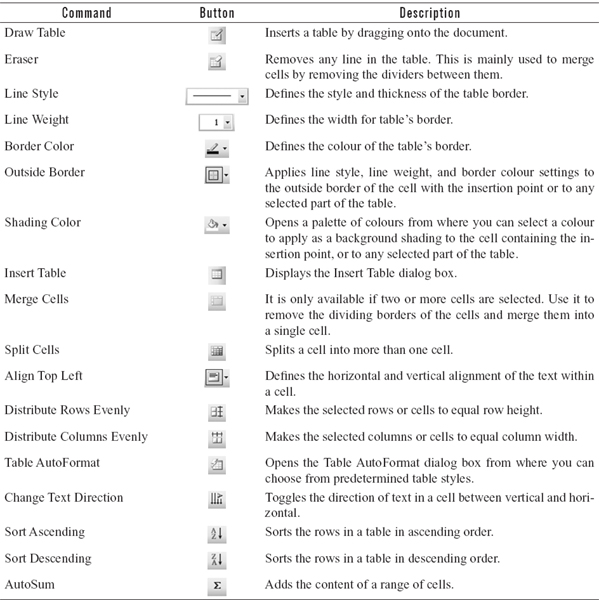
Selecting Parts of a Table
For working with the tables, one must have to select the different parts of the table. Selection allows formatting or deleting different parts of the table. Moreover, it also allows adding extra rows and columns in the table.
Different parts of a table can be selected either by using mouse or by using the shortcuts listed in Table 7.6.
Table 7.6 Shortcuts used to Select a Table
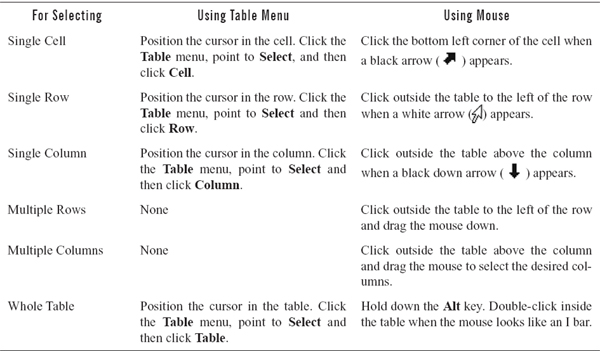
7.5.1 TABLE PROPERTIES
The Table Properties dialog box is used to modify the alignment of the table with the body text and the text within the table. This dialog box can be displayed by right-clicking in any cell and choosing Table Properties from the pop-up menu. This dialog box shows the current settings for the selected table. These settings appear as options in four different tabs: Table, Row, Column, and Cell.
Click on Table tab to format size, alignment, and text wrapping. The Row tab is used to change the cell's height and alignment. To format the columns, just click on the Column tab. Here you can set the width of each column according to the requirement. Every column can be of the same width, or of different width. Note that the formatting will be applied only to the sections that have been selected. When you finish making changes to the table, click on OK button to close the dialog box.
Figure 7.34 Table Properties Dialog Box
7.5.2 MOVING AND RESIZING TABLE
When you place the mouse over the table, a move handle and a resize handle will appear on the top-left and bottom-right corners of the table respectively. Click and drag the move handle to move the table and release the mouse button when the table is positioned where you want. Click and drag the resize handle to resize the table. You can also change the column width and row height. Move the mouse pointer onto the column line at the right of the column whose width you wish to alter. The pointer will change to (![]() ). Click and drag this to the right to increase the column width or to the left to decrease the column width. Similarly, you can also change the height of cells on a row or rows within the table by dragging the row resizer (
). Click and drag this to the right to increase the column width or to the left to decrease the column width. Similarly, you can also change the height of cells on a row or rows within the table by dragging the row resizer (![]() ) in upward or downward direction.
) in upward or downward direction.
Figure 7.35 Moving and Resizing Table
7.5.3 FORMATTING TEXT IN TABLE
Like word paragraphs, text stored in table cells can also be formatted. All the usual formatting options such as text alignment, bullets and numbering, indentation, spacing, tab stops, font colors, font styles, borders and shading, etc., work well within tables and cells. To make the text stored in a row of the table bold and italic, follow the steps given below:
- Select the row to be formatted.
Figure 7.36 Row Selected in a Table
- Click appropriate buttons on the Formatting toolbar to format the text in the selected row.
Figure 7.37 Formatting the Table
Aligning Text
Whenever you create a new table and enter text, by default, it is left aligned. However, you can change the text alignment if required. The text in the table can be justified and aligned to the centre or right side. To change the alignment of the text, follow the steps given below:
- Select a cell or a series of cells or an entire row or column.
- Click appropriate alignment button on the Formatting toolbar to align the selected text.
Figure 7.38 Aligning Text in Table
Positioning Text
When you enter text in tables, by default it is positioned horizontally in the table cells. However, Microsoft Word allows you to change the text orientation in table cells so that it can be positioned in a vertical direction. To perform this, follow the steps given below:
- Place the cursor in the cell where the text is to be typed.
- Select Text Direction from the Format menu to display the Text Direction dialog box.
- Select the desired text style and click OK. Now, if you type text in the cell, it appears in the same orientation as you selected.
Figure 7.39 Changing Orientation of the Text in the Table
Using Table AutoFormat
To make a table more presentable, Microsoft Word provides Table AutoFormat feature that allows to apply different formats such as borders, shading, special fonts and colour, etc., to a table in a quick and easy manner. To apply an AutoFormat to a table, follow the steps given below:
Figure 7.40 Table AutoFormat Dialog Box
- Place the cursor anywhere in the table.
- Select Table AutoFormat from the Table menu or click Table AutoFormat (
 ) button on the Tables and Borders toolbar to display the Table AutoFormat dialog box (see Figure 7.40).
) button on the Tables and Borders toolbar to display the Table AutoFormat dialog box (see Figure 7.40). - Click on the desired format from the Table styles section. Note that you can preview the selected format in the Preview box.
- To apply special formats, click the check boxes under the Apply special formats to section. The options included in this section indicate where AutoFormat will place distinctive formatting for the headings or for the entire text in the table.
- Click Apply to apply the formatting and close the Table AutoFormat dialog box.
Figure 7.41 Using Table AutoFormat
7.5.4 ADDING AND DELETING ROWS AND COLUMNS
New rows can be added to an existing table. The simplest way to do this is to move the cursor to the last column of the last row and press the Tab key. You can also insert rows by using the Table menu. On the Table menu, point to Insert and then choose Rows Above or Rows Below. Similarly, columns can be added by selecting the Columns to the Left or Columns to the Right.
For deleting rows and columns from the table, click inside the row or column that you wish to delete or select several rows or columns to delete. On the Table menu, point to Delete, and then click Rows or Columns.
7.5.5 CONVERTING TEXT TO TABLE
You can convert any text whether it is a tabbed list or a series of paragraphs, into a table using the Convert Text to Table feature of the Word. To perform this, follow the steps given below:
- Select the text to be converted into table.
- Select Convert from the Table menu and choose Text to Table option to display the Convert Text to Table dialog box.
- Enter the required number of columns and rows in the Table size section.
- Click the desired options in the AutoFit behavior section to specify the columns’ sizing.
- Select the desired delimiter or separator in the Separate text at section in order to specify what text to be added in an individual cell.
Figure 7.42 Converting Text to Table
7.5.6 CONVERTING TABLE TO TEXT
You can also convert an existing table to text using the Convert Table to Text feature of the Word. To convert a table to text, follow the steps given below:
- Select the text in table.
- Select Convert from the Table menu and choose Table to Text option to display the Convert Table to Text dialog box.
- Select the desired delimiter or the separator in the Separate text with section that will separate the different columns.
Figure 7.43 Converting Table to Text
7.6 CHECKING SPELLING AND GRAMMAR
Microsoft Word allows you to check spelling and grammar in the desired text in a document. Before printing or reading a document, you should always check for typing errors. Spelling and grammar errors are highlighted in the document with a red and green underlines, respectively, and may provide corrective suggestions. It can thus help you become better spellers, even broaden your vocabulary if you are curious enough to check out the meanings of the many words you have never come across before.
7.6.1 USING THE AUTO SPELL AND AUTO GRAMMAR FEATURES
Microsoft Word automatically checks the spelling and grammar as you type the text and provides visual clues about the spelling and grammar unless this feature is turned off. Misspelled words are underlined in red, while sentences with grammatical flaws are underlined in green. Note that these lines are for viewing purposes only and will not be printed.
Although spelling and grammatical errors can be corrected manually, Word provides easy-to-use assistance when you right-click on the error, as shown in Figure 7.44. When you right-click on a spelling or grammatical error, Word displays a pop-up menu with suggestive corrections. Select the desired correction and Word will automatically make the correction.
Figure 7.44 Auto Spell and Grammar Checking
7.6.2 USING SPELLING AND GRAMMAR DIALOG BOX
To start the spell check process, perform any of the following steps:
- Click the Spelling and Grammar button (
 ) on the Standard toolbar.
) on the Standard toolbar. - Select Spelling and Grammar from the Tools menu.
When you perform any of the above actions, Word 2003 will stop at words that it does not recognise, as well as repeated words, such as, “this this is a mistake”, in the Spelling and Grammar dialog box. You can choose from the choices Microsoft Word offers, type in your own change, or ask to ignore that instance or all instances of the word in the document (see Figure 7.45).
The top section of the dialog box contains the first unrecognised word—shown in red with its accompanying sentence so you can see how you have used the word within the document. The bottom section contains suggestions for correcting the word. If the word should remain as it is, select the Ignore Once button. Word also offers the option of Ignore All if the word in question appears throughout the document. If one of the suggestions is correct, double-click on the correct spelling or highlight the word and choose the Change button. If you are afraid you misspelled a word more than once, click on the Change All button. If the word should be added to the custom dictionary, click the Add to Dictionary button. You can use the AutoCorrect button to add the word to the AutoCorrect list. In the future, when you misspell this word while typing, Word will automatically correct it—without you having to access the spell checker. When you click the just mentioned buttons, Word will continue the spelling and grammar checking until it finds the next mistake or when there are no mistakes left in the document or the selected text.
Figure 7.45 Spelling and Grammar Dialog Box
7.6.3 USING AUTOCORRECT OPTIONS
The AutoCorrect Options feature automatically detects common errors like misspelled words, grammatical errors, and incorrect capitalization, and replaces them with the correct text. For example, “grammer” can be rectified as “grammar”. You can also use AutoCorrect to quickly insert text, graphics, or symbols. For example, type (c) to insert ©, or type asap to insert as soon as possible. There are several words available in the AutoCorrect dictionary; however, you can also enter a word that is commonly misspelled in the dictionary by selecting AutoCorrect Options from the Tools menu. This will display the AutoCorrect dialog box. In this dialog box, type in the misspelling in the Replace textbox and the corrected spelling in the With textbox. After that click the Add button and then close the dialog box by clicking the OK button.
Figure 7.46 AutoCorrect Dialog Box
7.6.4 USING SYNONYMS AND THESAURUS
Sometimes you may wish to replace a word with its synonym. Microsoft Word has the Thesaurus feature, which does just the same. To use this feature, follow the steps given below:
- Place the cursor on the word that is to be looked up.
- On the Tools menu, select Language and then select Thesaurus to display the Research task pane.
- A listing of similar words is provided under the Thesaurus: English (U.S.) section. To use a word from the list, point to it, click the down arrow and then click Insert or Copy. You can also view the similar words of any word in the list by clicking that word.
You can also quickly look up a word directly from within your document. To do this, select the word in contention, right-click it, and then choose Synonyms from the pop-up menu. From the list of suggested words, choose any one you like or select the Thesaurus option to display the Research task pane.
Figure 7.47 Research Task Pane
Figure 7.48 Finding a Synonym
7.7 ADDING GRAPHICS TO DOCUMENT
Graphics are frequently used with text to add emphasis and visual impact in Word documents. Microsoft Word 2003 uses two basic types of graphics: pictures and drawing objects.
7.7.1 PICTURES
Pictures are used in the document to enhance its readability and understandability. These include bitmaps, scanned pictures, photographs, and clip art. You can use any image editing software to create photographs, line drawings, and other graphics, as long as you can save the file in a format that Word 2003 recognises. Some common formats are .BMP, .GIF, .JPG, and .WMF.
Inserting Picture from a File
Word allows you to insert pictures or scanned photographs from other programs and locations into the Word document. To add photographs or graphics to an existing file, follow the steps given below:
- Click on the desired location, where the picture is to be inserted.
- On the Insert menu, click Picture, and select From File. This opens the Insert Picture dialog box as shown in Figure 7.49.
- Use the Look in drop-down box to find the image to be inserted.
- Select the file name from the list and click the Insert button.
Figure 7.49 Insert Picture Dialog Box
Clip Art
Microsoft Word comes with its own set of pictures in the Clip Gallery. The Clip Gallery includes a wide variety of clip art that makes it easy for you to enhance your documents with professionally designed images. Most clip art images are in metafile format, which means you must ungroup an image and convert it to a drawing object in order to enhance it. To add a Clip Art from the Clip Gallery, follow the steps given below:
- CLICK on the desired location, where the clip image is to be inserted.
- On the Insert menu, click Picture, and select Clip Art to display the Clip Art task pane. You can also open Clip Art Gallery by clicking Insert Clip Art button (
 ) on the Drawing toolbar.
) on the Drawing toolbar.
Figure 7.50 Insert Clip Art Task Pane
Figure 7.51 Inserting Clip Art
- To find an image, click in the box following Search for and enter keywords describing the image you want to use and Click on Go button.
- Move the mouse on the image to be inserted and click drop-down arrow alongside the image. This opens the pop-up menu, which is shown in Figure 7.51.
- Click Insert from the menu to insert the image. You can also drag a picture or other clip from the Clip Gallery to your document.
- To add multiple images, continue selecting images to be added to the document. When you are finished using the Clip Gallery, click the Close button on the Clip Gallery title bar to close Clip Art task pane.
7.7.2 EDITING A PICTURE
Once an image is inserted, it can be changed and enhanced by using the Picture toolbar. To edit an image, follow the step given below:
- Select the graphic by clicking on it so the selection handles appear on the sides and corners of the picture. Click and drag these handles to resize the image. To resize the object, place the mouse pointer over one of the selection handles until it becomes a double-headed arrow (
 ). The picture can be resized in three ways: horizontally, vertically, or in proportion.
). The picture can be resized in three ways: horizontally, vertically, or in proportion.
1. TO stretch horizontally, drag either of the side handles.
2. To stretch vertically, drag the handle to either the top or the bottom.
3. To resize proportionally, drag one of the corner handles.
Figure 7.52 Selecting Picture for Editing
Image effects can also be changed by using the Picture toolbar. When you select a picture, the Picture toolbar appears with tools that you can use to crop the picture, add a border to it, or adjust its brightness and contrast. If the Picture toolbar does not appear, right-click the picture and select Show Picture Toolbar from the shortcut menu.
Table 7.7 lists all the available buttons on the Picture toolbar.
Table 7.7 Picture Toolbar Options

7.7.3 DRAWING OBJECTS
Word allows you to add objects such as lines, curves, and WordArt. The drawing objects include:
- AutoShapes: It comprises lines, curves, basic shapes, and many such objects.
- WordArt: It comprises text written using special effects.
AutoShapes
Microsoft Word comes with a set of ready-made AutoShapes containing several categories of shapes, including lines, basic shapes, flowchart elements, stars and banners, and callouts that you can use in your documents. You can resize, rotate, flip, colour, and combine the shapes with other shapes such as circles and squares to make shapes that are more complex. To use AutoShapes, follow the steps given below:
- On the Insert menu, click Picture and then select AutoShapes.
Or
On the View menu, click Toolbars and then select Drawing to display the Drawing toolbar. This toolbar contains the AutoShapes menu.
Figure 7.53 AutoShapes Menu
Table 7.8 AutoShapes Menu Options
Table 7.8 lists all the available buttons on the AutoShapes menu.
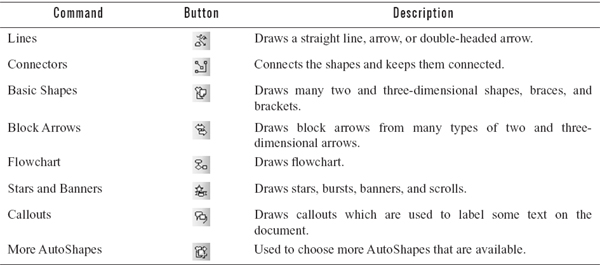
- Select the required shape on the toolbar. Use the drag-and-drop method to draw the shape in a document.
- When the shape has been made, it can be resized using the sizing handle and other adjustments specific to each shape can be modified using the yellow diamond handles. Each AutoShape can be rotated by clicking and dragging the green handles around the image to rotate it.
Figure 7.54 Inserting AutoShapes
Figure 7.55 Resizing and Rotating AutoShapes
WordArt
Using WordArt Gallery, you can create many text effects. You can create shadowed, skewed, rotated, and stretched text, as well as text that can be fitted to pre-defined shapes. To insert a WordArt drawing object, follow the steps given below:
Figure 7.56 WordArt Gallery Dialog Box
- Click Insert WordArt button (
 ) on the Drawing toolbar. Alternatively, select Picture from the Insert menu, and then select WordArt. When you perform any of these actions, the WordArt Gallery dialog box is displayed (see Figure 7.56).
) on the Drawing toolbar. Alternatively, select Picture from the Insert menu, and then select WordArt. When you perform any of these actions, the WordArt Gallery dialog box is displayed (see Figure 7.56). - Select a WordArt style to apply to the document and click OK to close the dialog box. This opens Edit WordArt Text dialog box (see Figure 7.57), where text is entered for the chosen style.
- Select a font by clicking the down arrow next to the Font list. The font size can also be selected by clicking the down arrow next to the Size box. To make the text bold, click the (
 ) button, and to make the text italics, click the (
) button, and to make the text italics, click the ( ) button.
) button. - When text has been entered and font selection made, click OK (see Figure 7.58). The WordArt now appears in the document. With the selection handles visible on the WordArt, you can resize, move, and rotate the WordArt.
To add or change effects to the text, use the buttons on the WordArt and Drawing toolbars. The WordArt toolbar appears when you click the WordArt special text. Table 7.9 lists all the available buttons on the WordArt toolbar.
Figure 7.57 Edit WordArt Text Dialog Box
Figure 7.58 WordArt in Document
Table 7.9 WordArt Toolbar Options
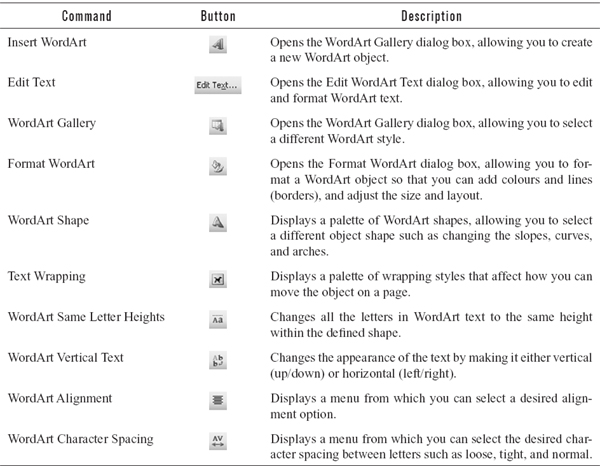
Drawing Toolbar
The Drawing toolbar is used to change and enhance the drawing objects with colours, patterns, borders, and other effects. The drawing toolbar includes the following options:
Table 7.10 Drawing Toolbar Options
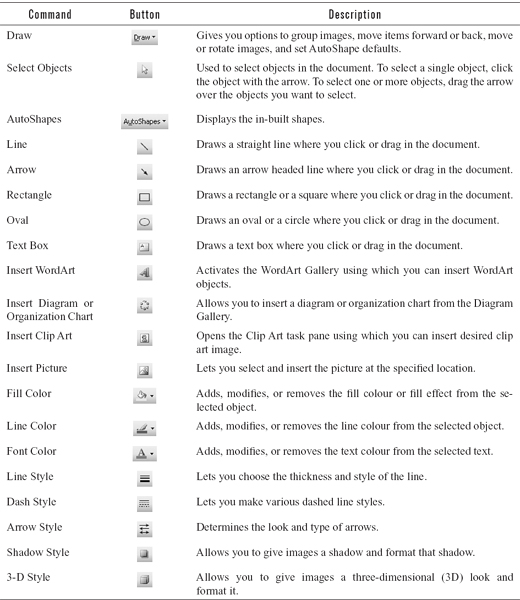
7.8 MAIL MERGE
Mail merge feature of Word allows you to merge generic information which is to be repeated in each letter, mailing label, or, envelope, etc., with varying information like, a list of names and addresses of employees. This allows to have almost identical documents in which the content of the documents is the same for each employee, however, each of them can be customised for a particular individual in the list. For example, if one wants to send a form letter to five or five hundred different people, Word can be used to personalise each one and create envelopes or mailing labels.
7.8.1 COMPONENTS OF A MAIL MERGE
The components of the mail merge are as follows:
- The main document comprises the generic information in the form of text and graphics. It also determines the format of the resultant merged document. The five types of main documents are:
- Letters: To create letters that can be sent to a group of people.
- E-mail messages: To create e-mail messages that can be sent to a group of people.
- Envelopes: To create addressed envelopes for a group mailing.
- Labels: To create address for a group mailing.
- Directory: To create a directory containing a printed list of addresses or a catalog.
- A data source comprises varying information in which records representing individual items are stored. Each record consists of fields, for example, a record of an employee may consist of name and address, where name may consist of fields, FirstName and LastName and the address may contain fields HouseNo, City, and State. A data source contains multiple records, representing information for numerous employees.
Figure 7.59 Sample Text
- The merged document comprises the combination of generic text and variable information. In the main document, you can insert merge fields indicating the place where you want to place the variable information. When the information in the data source is merged with the main document, the merge fields are replaced with the variable information representing the data for each individual.
7.8.2 MAIL MERGE STEPS
To perform mail merge, follow the steps given below:
- Click New (
 ) on the Standard toolbar to create a document and type the desired text. For example, enter the text in new file as shown in Figure 7.59 and save it. An already existing file can also be used as the main document. If you already have a document containing the desired text, open it.
) on the Standard toolbar to create a document and type the desired text. For example, enter the text in new file as shown in Figure 7.59 and save it. An already existing file can also be used as the main document. If you already have a document containing the desired text, open it. - Click the Tools menu, point to Letters and Mailings, and then click Mail Merge to display the Mail Merge task pane (see Figure 7.60).
- Select the appropriate option under the Select document type section. For example, select the option Letters to create a letter.
- Click Next: Starting document button to perform the next step of mail merge (see Figure 7.61).
- Click Use the current document option under the Select starting document section to use the currently opened document as the main document.
Figure 7.60 Step 1: Select Document Type
Figure 7.61 Step 2: Select Starting Document
Figure 7.62 Step 3: Select Recipients
Figure 7.63 Step 3 with Type a new list Option Selected
Figure 7.64 New Address List Dialog Box
- Click Next: Select recipients to perform next step of the mail merge (see Figure 7.62). You can click Previous: Select document type to return to previous step and change the selection options.
- Select Type a new list under the Select recipients section to create the address list (see Figure 7.63).
Figure 7.65 Save Address List Dialog Box
- Click Create button to display the New Address List dialog box (see Figure 7.64).
- In the New Address List dialog box, type the appropriate information you want to include for the first entry in the boxes under Enter Address information section. Note that as you start entering the information, the Cancel button changes to Close button.
- Click New Entry button to complete the first entry and enter a new entry.
- Repeat steps 9 and 10 until you have added all the address entries and click the Close button to display the Save Address List dialog box (see Figure 7.65).
- Specify the name of the file, location of the file and the file type.
- Click Save button to display the Mail Merge Recipients dialog box (see Figure 7.66).
- In the Mail Merge Recipients dialog box, click the heading of the column you want to use to sort the list. You can also add or remove the recipients from the mail merge list by clicking the check box beside the name of the recipient. Click OK button to close the Mail Merge Recipients dialog box and return to the Mail Merge task pane.
- Click Next: Write your letter to perform next step of the mail merge and to display the mail merge toolbar. Some of the tools are listed in Table 7.11.
Figure 7.66 Mail Merge Recipients Dialog Box
Table 7.11 Mail Merge Toolbar Options

Figure 7.67 Step 4 of Mail Merge
- Place the cursor at the location in the main document where you want to insert the merge fields, that is, where you want to merge name, addresses etc. from the data source (see Figure 7.67).
- Click the Address block under the Write your letter section to display the Insert Address Block dialog box (see Figure 7.68).
- Select the desired format and click OK button. A merge field for the address appears in the letter. This merge field will be replaced with an address from the address list (see Figure 7.69).
- Similarly, you can add Greeting Line if you want to add a greeting in the letter.
- Click Next: Preview your letters to perform the next step of the mail merge (see Figure 7.70).
- Click Next: Complete the merge to finish the mail merge (see Figure 7.71).
Figure 7.68 Insert Address Block
Figure 7.69 Merge Field for Address
Figure 7.70 Step 5 of Mail Merge
Figure 7.71 Step 6 of
Figure 7.72 Merge to New Document Dialog Box
Figure 7.73 Merged Document
- Click Edit individual letters under the Merge section to merge the main document with the information from the mailing list. The Merge to New Document dialog box appears (see Figure 7.72).
- Click the appropriate option to specify the records you want to merge.
- Click OK to create letters (see Figure 7.73).
7.9 PRINTING A DOCUMENT
A major part of any word processing software is to print a document. Microsoft Word allows you to choose what part of the document to print (such as the current page, multiple pages or the entire file). In addition, you can specify which printer to use and how many copies to print.
7.9.1 SETTING PAGE MARGINS
Page margins determine the distance between the text and the edge of the paper. To specify the margins in the document, choose Page Setup from the File menu to display the Page Setup dialog box. As shown in Figure 7.74, Microsoft Word 2003’s default margins are 1.25 inches on the left and right and 1 inch on the top and bottom. If required, change the margin from top, bottom, left, and right. To change the orientation (whether to print the document in landscape or portrait mode), select the option from the Orientation section. If you plan to print on both sides of the page, select the Mirror margins option from the Multiple pages drop-down list under Pages sections so that the margins on facing pages mirror each other. The Preview box at the right of the Page Setup dialog box displays thumbnail-sized representation of a sample page in your document. Be sure that your margins are appropriate for your document.
Figure 7.74 Page Setup Dialog Box
The Page Setup dialog box also allows you to format the size and orientation of the paper. To change the size of the paper, click the Paper tab and select the desired size (letter, A4, etc.) from the Paper_size list.
7.9.2 PRINT PREVIEW
Print preview is a way to view the appearance of the printed document onscreen before printing the final output. Previewing the document is a great way to catch formatting errors, such as incorrect margins, overlapped text, boldfaced text, and other text enhancements. This helps in saving costly printer paper, ink, and time. To view document in print preview mode, choose Print Preview from File menu or click the Print Preview button (![]() ) on the Standard toolbar. In the print preview mode, the document appears as a reduced image in the Print Preview screen. The Zoom feature can be used to magnify the image for readability. To magnify the text for a larger view, click the Magnifier button (
) on the Standard toolbar. In the print preview mode, the document appears as a reduced image in the Print Preview screen. The Zoom feature can be used to magnify the image for readability. To magnify the text for a larger view, click the Magnifier button (![]() ) and place the cursor over the text you wish to enlarge. When the cursor resembles a magnifying glass encircling a + sign (
) and place the cursor over the text you wish to enlarge. When the cursor resembles a magnifying glass encircling a + sign (![]() ), click the text and the text will be zoomed in. You can magnify any portion of the page. To return to the original view size, position the cursor over the text again and when the cursor resembles a magnifying glass encircling a – sign (
), click the text and the text will be zoomed in. You can magnify any portion of the page. To return to the original view size, position the cursor over the text again and when the cursor resembles a magnifying glass encircling a – sign (![]() ), click to reduce the text to a smaller magnification. Click Close to return to the document.
), click to reduce the text to a smaller magnification. Click Close to return to the document.
Figure 7.75 Print Preview
7.9.3 PRINTING THE DOCUMENT
Once you are ready with all the formatting and editing, you can print the document. To print a document, click the Print button (![]() ) on the Standard toolbar, or select Print from the File menu to display the Print dialog box (see Figure 7.76). This dialog box allows you to select the number of copies and how many pages of the document you want to print. You can also specify the range of the document to print by choosing:
) on the Standard toolbar, or select Print from the File menu to display the Print dialog box (see Figure 7.76). This dialog box allows you to select the number of copies and how many pages of the document you want to print. You can also specify the range of the document to print by choosing:
- All: To print all the pages of the document.
- Current page: To print the current page in the document.
- Pages: To print certain number of pages.
- Selection: To print the selected portion of the document.
The Number of copies list allows you to enter the number of copies you want to print. If you want to print multiple copies, select the Collate check box to print a complete copy of the document before the first page of the next copy is printed. Now, the copies will come out in the order page 1, 2, 3; page 1, 2, 3 etc. The Pages per sheet list offers you to select the number of pages in the document that you want to print on each sheet of paper. Once all printer settings have been set, click OK and Word will begin printing the document.
Figure 7.76 Print Dialog Box
7.10 ADVANCED FEATURES OF MICROSOFT WORD
Microsoft Word's built-in feature Index and Tables provides a convenient way of creating table of contents and index for a word document. The Template feature of Word helps in creating the basic structure for the documents used more frequently in day-to-day working.
7.10.1 USING INDEX AND TABLES
The Index and Tables feature has two options: Table of Contents and Index which are used to create a table of contents and index, respectively for a Word document. The user only has to mark the text to be included in table of contents or index and give simple commands, the Word will automatically create a table of contents and index for that document.
Using Table of Contents
One of the most common features of a professional document is the Table of Contents (TOC). A table of contents is an organised list of heading of topics in the order in which they appear in a document. A user can easily access any topic being discussed in the document by locating its position in the document from table of contents. Usually when table of contents is printed, it includes the page numbers of document where headings are present. In web page layout, the headings act as links to go to corresponding headings. Creating TOC in Word using Table of Contents option is a two-step process: marking the headings to be included in TOC and giving commands to insert a TOC in the document.
To mark headings to be included in a TOC, follow these steps.
- Open the Word document of which TOC is to be created.
- In the document, select the top-level heading and apply the Heading 1 style to it. The Heading 1 style can be applied by clicking the Style drop-down box on the Formatting toolbar (see Figure 7.77) and choosing Heading 1.
- Similarly, apply the Heading 1 style to all other top-level headings in a document. Apply the Heading 2 style to the second level headings, the Heading 3 style to the third level headings and so on.
Consider the sample document shown in Figure 7.78 with appropriate heading styles applied.
To give commands to insert a TOC in the document, follow these steps.
- Place the cursor at the location where the TOC is required.
- Select Reference from the Insert menu and then choose Index and Tables from the pop-up menu to display the Index and Tables dialog box (see Figure 7.79).
- Click the Table of Contents tab. This tab contains various options for formatting TOC.
Figure 7.77 Style Drop-Down Box.
- Show page numbers: Select the check box if page numbers are to be included in TOC.
- Formats: Used to select the style of TOC.
- Show levels: Used to specify the number of levels of headings to be included in TOC.
- Once the options are selected, click OK to insert the TOC at the cursor position. The TOC of sample document will appear as shown in Figure 7.80.
Figure 7.78 Sample Document with Appropriate Heading Styles Applied
Figure 7.79 Table of Contents Tab on Index and Tables Dialog Box
Figure 7.80 Table of Contents of Sample Document
Using Index
An index is an alphabetical list of words, phrases or topics discussed in a document. Microsoft Word provides a convenient way to create index from a list of keywords or topics marked as index entry. It provides an easier and faster access to the words or phrases appearing in the document. Creating index in Word using Index option is also a two-step process: marking the words or phrases to be included as Index Entry and giving command to insert an index in the document.
To mark words or phrases to be included in an index, follow these steps.
- Select the word to be included in the index.
- Select Reference from the Insert menu and then choose Index and Tables from the pop-up menu to display the Index and Tables dialog box (see Figure 7.81(a)).
- Click the Index tab. Click on Mark Entry to display the Mark Index Entry dialog box. The selected word will appear as Main entry in the dialog box (see Figure 7.81(b)).
- Click on Mark or press enter to insert a field code for the selected word as an index entry. The dialog box remains open for more words to be marked as index entry. Repeat the procedure for each and every word to be included in the index.
- Click Close to close the dialog box after marking all the required words.
To give commands to insert an index in the document, follow these steps.
- Place the cursor at the location where the index is required.
- Select Reference from the Insert menu and then choose Index and Tables from the pop-up menu to display the Index and Tables dialog box.
- Click the Index tab. This tab contains various options which can be used to specify the style and language of index. Number of columns for index can also be specified.
- Once the options are selected, click OK to insert the index at the cursor position.
The index of sample document will appear as shown here.
Figure 7.81 Creating Index
Figure 7.82 Index of Sample Document
7.10.2 USING TEMPLATES
A template determines the basic structure for a document and contains document settings such as text, formatting, page layout options such as margins, styles, headers and footers, graphics, customised toolbars, menus, and shortcut keys. Template allows a user to create master documents, which may be used for files with standard information or formatting codes.
When a document is based on a template, changes made in the document are saved in the document file, but the template remains in its original state to be used again. You can use an existing template to create your document as well as create a new template also.
Figure 7.83 Templates Dialog Box
Table 7.12 Differences between the Templates and Documents
| Templates | Documents |
| Template provides a basic structure containing all the elements which do not change. | Documents when created are based on already existing templates. |
| Templates are saved with extension. dot. | Documents are saved with extension. dot. |
| For example, a template for a memo will usually contain the headings such as From, To, CC, etc. These headings will appear in all documents based on this template. | Whenever new document is created, it is based on a template. If no template is selected, the default template that will be used is the Normal template. |
Using Existing Templates
Microsoft Word comes with various types of templates like General, Memos, Letters & Faxes, Reports, Publications, etc. To create a new document from an existing template, follow the steps given below:
- Select New from the File menu to display the New Document task pane.
- Click the On my computer option under Templates section to display the Templates dialog box.
- Click on the desired template (see Figure 7.83).
- Select Document under the Create New section as the type of new file to be created is document.
- Click OK to close Templates dialog box and open a new document based on the selected template.
Note: Clicking on the New button on the Standard toolbar creates a document based on Normal template, the default template of Microsoft Word.
Creating a New Template
A new template can also be created from scratch based on specific requirements of the user. To create a new template, follow the steps given below:
- Select New from the File menu to display the New Document task pane.
- In the New Document task pane, click the On my computer under Templates section to display the Templates dialog box.
- Select Blank Document under the General tab.
- Select Template under the Create New section as the type of new file to be created is a template (see Figure 7.84).
- Click OK to open a blank document with Template1 as its title.
- Select all the formatting features, tab settings and margins as per your requirement.
- Once the document is formatted, select Save from the File menu to display the Save As dialog box.
- In the File name box, type a descriptive name for the new template and click the Save button.
- Select Close from the File menu to close the template file.
The new template created will appear on the General tab in the New dialog box and can be used to create a new document based on this template.
Note: If the template is saved in a folder other than the Templates folder it will not be included in the New dialog box.
Figure 7.84 Template Dialog Box to Create New Template
7.10.3 USING MACROS
A macro is a series of Word commands that have been grouped together as a single command to automate a task. Macros are mainly used to speed up routine editing and formatting or to combine multiple commands; for example, inserting a table with a specific number of rows and columns and with specific size and borders.
A macro can be created by either recording the steps using the macro recorder or typing the macro in Visual Basic Editor. To create a macro using macro recorder, follow the steps given below:
Figure 7.85 Record Macro Dialog Box
- Click the Tools menu, point to Macro, and select Record New Macro from the pop-up menu to display the Record Macro dialog box.
- Type a name for the macro in the Macro name box.
- Click the template or document in which you want to store the macro in the Store macro in list box.
- Type a description for the macro in the Description box.
- Click Keyboard to assign the macro to shortcut keys. The Customize Keyboard dialog box is displayed (see Figure 7.86).
- Click the macro you are recording in the Commands box. Type the key sequence, say, Alt+K in the Press new shortcut key box.
- Click Assign button to assign the macro to the key sequence and then click Close to begin recording the macro and display the Stop Recording toolbar (see Figure 7.87).
- Perform the actions you want to include in your macro. For example, if you want to create a macro for formatting the text, then follow these steps.
- i) Select Font from the Format menu to display the Font dialog box (see Figure 7.88).
- ii) In Font dialog box, specify the desired formatting.
- iii) Select Paragraph from the Format menu to display the Paragraph dialog box (see Figure 7.89).
- iv) Specify the desired paragraph formatting in Paragraph dialog box.
- To stop recording your macro, click Stop Recording button (
 ) on Stop Recording toolbar.
) on Stop Recording toolbar.
Figure 7.86 Customize Keyboard Dialog Box
Figure 7.87 Stop Recording Toolbar
Figure 7.88 Font Dialog Box
Figure 7.89 Paragraph Dialog Box
To run a macro, follow the steps given below:
- Click the Tools menu, point to Macro, and select Macros from the pop-up menu that appears to display the Macros dialog box (see Figure 7.90).
- Click the name of the macro you want to run in the Macro name box. Note that if the macro does not appear in the list, select a different document or template in the Macros in box.
- Click Run button.
Figure 7.90 Macros Dialog Box
Note: While recording a macro, you can use the mouse to click commands and options, but not to select text. To record selection actions, the keyboard must be used. For example, to select text, you can use F8 and to move the cursor to the end of the line, you can press END.
IMPORTANT KEYBOARD SHORTCUTS
DOCUMENT ACTIONS
| Action | Shortcut Key |
| Open a Document | CTRL+O |
| Create a New Document | CTRL+N |
| Close a Document | CTRL+W |
| Save As | F12 |
| Save | CTRL+S |
| Help | F1 |
| Print Preview | CTRL+F2 |
| CTRL+P | |
| Close Word Application | ALT+F4 |
TEXT FORMATTING ACTIONS
TABLE ACTIONS
| Action | Shortcut Key |
| Next Cell | Tab |
| Previous Cell | SHIFT+Tab |
| Beginning of Column | ALT+PageUp |
| End of Column | ALT+PageDown |
| Select Table | ALT+ (Num 5) |
| (keeping NumLock OFF) |
MISCELLANEOUS ACTIONS
| Action | Shortcut Key |
| Thesaurus | SHIFT+F7 |
| Spellchecker | F7 |
LET US SUMMARISE
- Word processing is the manipulation of characters, words, text, numbers, sentences, and paragraphs in the document so that they are error-free and looks attractive.
- To open Microsoft Word, click start, point to All Programs, and then select Microsoft Word.
- To get help, click the Microsoft Word Help button (
 ) on the Standard toolbar. Alternatively, select Microsoft Office Word Help from the Help menu.
) on the Standard toolbar. Alternatively, select Microsoft Office Word Help from the Help menu. - To create a new document, click on New Blank Document button (
 ) on the Standard toolbar. Alternatively, select New from the File menu.
) on the Standard toolbar. Alternatively, select New from the File menu. - To open an existing document, click on the Open button (
 ) on the Standard toolbar. Alternatively, select Open from the File menu.
) on the Standard toolbar. Alternatively, select Open from the File menu. - To save the document, Microsoft Word provides two menu options, namely, Save and Save As. By default, Microsoft Word document files are saved with .DOC extension. Although it can also be saved in other file formats like .TXT, .RTF and .HTML.
- To close the document, select Close from the File menu.
- Formatting is the process of determining how the typed text will appear on a printed page. It is applied by altering the appearance of text by setting the font type and font size, line spacing, and colour. To format the text, first select the text to be formatted, and then use various buttons on the Formatting toolbar. Text can also be formatted by using the Font dialog box, which can be displayed by selecting Font from the Format menu.
- To highlight the text use the Highlight button (
 ) from the Formatting toolbar. In case you want to change the colour of the text, use the Font Color button (
) from the Formatting toolbar. In case you want to change the colour of the text, use the Font Color button ( ) from the Formatting toolbar.
) from the Formatting toolbar. - To align or indent a paragraph, use the appropriate buttons on the Formatting toolbar. A paragraph can also be formatted using the Paragraph dialog box, which can be displayed by selecting Paragraph from the Format menu.
- A style is a set of formatting specifications that can automatically be applied to the text. To apply a style, place the cursor in the paragraph where the style is to be applied. Then click the Style drop-down box on the Formatting toolbar and select a style by clicking on it.
- The Format Painter is a time saving feature for quickly copying the format of a block of text. This tool can be used by clicking the Format Painter button (
 ) on the Standard toolbar.
) on the Standard toolbar. - To move the text, choose Cut from the Edit menu. To copy the text, choose Copy from the Edit menu. To paste the cut or copied text or image, choose Paste from the Edit menu.
- To find and replace text within the document use the Find and Replace dialog box, which can be displayed by selecting Find from Edit menu.
- To undo the last action, select Undo from the Edit menu. To redo the last undo action, select Redo from the Edit menu. You can also use the Undo button (
 ) and Redo button (
) and Redo button ( ) from the Standard toolbar.
) from the Standard toolbar. - To use bullets and numbering, first select the text you want to format. Next, use the Bullets (
 ) or Numbering (
) or Numbering ( ) button on the Formatting toolbar.
) button on the Formatting toolbar. - Headers are text that appears at the top of every page, and footers contain text that appears at the bottom of each page. To create a header and footer in a document, select Header and Footer from the View menu, or double-click on the header area of the document.
- Tables can be created by using the Insert Table dialog box, which can be displayed by selecting Insert and then Table from the Table menu. Another way of creating a table is to click the Insert Table button (
 ) on the Standard toolbar and then dragging the mouse along the grid to highlight the number of rows and columns for the table.
) on the Standard toolbar and then dragging the mouse along the grid to highlight the number of rows and columns for the table. - Microsoft Word automatically checks the spelling and grammar as you type the text and provides visual clues about the spelling and grammar. Misspelled words are underlined in red, while sentences with grammatical flaws are underlined in green.
- Microsoft Word has the Thesaurus feature to replace a word with its synonym or antonym. This feature can be used by selecting Language and then Thesaurus from the Tools menu.
- To add a picture from an existing file, use the Insert Picture dialog box, which can be displayed by selecting Picture and then From File from the Insert menu.
- Microsoft Word comes with its own set of pictures in the Clip Gallery. This gallery includes a wide variety of clip art that makes it easy for you to enhance your documents with professionally designed images. To add a Clip Art from the Clip Gallery use the Insert ClipArt dialog box, which can be displayed by selecting Picture and then Clip Art from the Insert menu.
- To use AutoShapes, select Picture and then AutoShapes from the Insert menu. Alternatively, use the AutoShapes menu from the Drawing toolbar.
- To use WordArt, select Picture and then WordArt from the Insert menu. Alternatively, use the WordArt button (
 ) from the Drawing toolbar.
) from the Drawing toolbar. - Page margins determine the distance between the text and the edge of the paper. To specify the margins in the document use the Page Setup dialog box, which can be displayed by selecting Page Setup from the File menu.
- Print preview is a way to review the appearance of the printed document on-screen before printing the final output. To view document in print preview mode, choose Print Preview from File menu or click the Print Preview button (
 ) on the Standard toolbar.
) on the Standard toolbar. - To print a document, click the Print button (
 ) on the Standard toolbar. Alternatively, use the Print dialog box, which can be displayed by selecting Print from the File menu.
) on the Standard toolbar. Alternatively, use the Print dialog box, which can be displayed by selecting Print from the File menu. - Microsoft Word's built-in feature Index and Tables provides a convenient way of creating table of contents and index for a word document.
- A template determines the basic structure for a document and contains document settings such as text, formatting, page layout options such as margins, styles, headers and footers, graphics, customised toolbars, menus and shortcut keys.
- A macro is a series of Word commands that have been grouped together as a single command to automate a task. Macros are mainly used to speed up routine editing and formatting or to combine multiple commands.
EXERCISES
Fill in the Blanks
- __________ button from the Standard toolbar is used to see how a document looks before it is printed.
- A red line under a word in document means that there is a _________ error.
- To select a complete document, use the _________ keyboard shortcut.
- To cancel the last text modified, _______ button is used.
- _________ bar displays the name of the document.
- _________ and _________ are two basic toolbars in Word.
- A __________ is the message that appears on the screen to provide information about toolbar button.
- To save the document, Microsoft Word provides two options, namely, _________ and ________.
- _________ and __________ option in Microsoft Word is used to locate a particular word, phrase, or set of characters in a document, and replace it with something else.
- The Print button appears on __________ toolbar.
- Every Word document contains ________ and ________ areas where you can put a document title, author name, page number, and graphics.
- ___________ provide means of presenting information in an organised and attractive manner
- that displays text in grid of rows and columns of cells.
- _________ contains command buttons that provide single-click entry to carry out many text-processing tasks.
- ___________ is a time saving feature for quickly copying the format of a block of text.
- _________ toolbar allows you to add border styles, shading, text effects, alignment, and more option to a table.
Multiple Choice Questions
- The toolbar that contains buttons for formatting text and paragraph is:
- (a) Drawing
- (b) Formatting
- (c) Standard
- (d) Drawing
- To move data from one part of the document to another, following combination is used:
- (a) Cut and Paste
- (b) Cut and Delete
- (c) Copy and Undo
- (d) Cut and Insert
- To save a document for the first time ……………………. option is used.
- (a) Save As
- (b) Cut
- (c) Save
- (d) Paste
- To see the document before the printout is taken, following option should be used:
- (a) Insert Table
- (b) Print Preview
- (c) Paste
- (d) Format Painter
- Two basic types of graphics used in Word 2003 documents are:
- (a) Drawing Objects and Pictures
- (b) AutoShapes and Clip Art
- (c) Header and Footer
- (d) Spelling and Grammar
- Tables can be created in a number of ways, one of the most commonly used method is to create table by clicking on the ……………………. menu.
- (a) Format
- (b) Window
- (c) Help
- (d) Table
- A user can use the ……………………. and ……………………. commands to search for and correct words in a document.
- (a) Find and Replace
- (b) Print and Print Preview
- (c) Header and Footer
- (d) Spelling and Grammar
- The feature which automatically detects common errors, that is, misspelled words, grammatical errors is called:
- (a) Goto
- (b) Thesaurus
- (c) AutoCorrect
- (d) Spelling and Grammar
- Which of the following options is used to display information such as page numbers, title of the document, and page number in Word?
- (a) Insert Table
- (b) Header and Footer
- (c) AutoCorrect
- (d) Thesaurus
- A user can specify the margins (top, bottom, left, and right margins) in a document, by choosing Page Setup from the ……………………. menu.
- (a) Format
- (b) Table
- (c) AutoCorrect
- (d) File
- Which type of justification aligns text on both the right and left margins of a document?
- (a) Justify
- (b) Center
- (c) Right
- (d) Balanced
- To advance to the next cell in a table press the ……………………. key.
- (a) Enter
- (b) Tab
- (c) End
- (d) Insert
- When you cut and paste something, it is temporarily transferred to:
- (a) Another partition on the hard drive
- (b) Virtual Memory
- (c) Swap File
- (d) Clipboard
- A misspelled word is marked by:
- (a) Enclosing the word in a grey bar
- (b) Changing the display to a blinking word
- (c) Underlining the word with a solid black line
- (d) Underlining the word with a wavy red line
- The Print Preview icon:
- (a) Prints the document without page breaks
- (b) Displays statistics about the document
- (c) Saves the document in a print format
- (d) None of these
State True or False
- Microsoft Word is a part of Microsoft office suite.
- Word facilitates working in more than one document at the same time.
- Office Assistant helps the user to write text in Word 2003.
- The status bar shows information like page number, total number of pages, and so on.
- The green line under the text indicates a grammatical error.
- Underlining a word is an example of text formatting.
- When a document is saved, it cannot be modified.
- The printed copy of a document is called a hardcopy.
- Headings are used to provide style to the font.
- Bullets and Numbering buttons are available on Standard toolbar.
- Microsoft Word 2003 is an operating system.
- The Office Assistant button is on the Standard toolbar.
- The insertion point indicates where text will be inserted as you type.
- To centre selected paragraphs, click the Center button on the formatting toolbar.
- Word processor developed by Microsoft is Word Perfect.
Descriptive Questions
- What are the components of Print Preview toolbar?
- What do you understand by character and paragraph format?
- Give description of View menu.
- Differentiate between Save and Save As option.
- Differentiate between Undo and Redo command.
- Give the steps to use Thesaurus.
- Write short notes on:
- (a) Document view
- (b) Redo command
- (c) Thesaurus
- Give the steps involved in inserting a picture into a file.
- What are Headers and Footers in Word?
- Describe table and its parts briefly.
- Give steps for creating an invitation letter for your birthday party.
- What are templates and how are these helpful in Word?
ANSWERS
Fill in the Blanks
- Print Preview
- Spelling
- Ctrl+A
- Undo
- Title
- Standard and Formatting
- ScreenTip
- Save and Save As
- Find and Replace
- Standard 11. Headers and Footers
- Tables
- Toolbar
- Format Painter
- Tables and Borders
Multiple Choice Questions
- (b)
- (a)
- (a)
- (b)
- (a)
- (d)
- (a)
- (c)
- (b)
- (d)
- (a)
- (b)
- (d)
- (d)
- (d)
State True or False
- True
- True
- True
- True
- True
- True
- False
- True
- True
- False
- False
- True
- True
- True
- False

